Etosha National Park in Namibia is home to a plethora of fascinating bird species. With over 340 species of birds, it is a haven for bird enthusiasts and nature lovers alike.
From raptors and waterbirds to passerines and owls, the park’s diverse landscape provides an ideal habitat for a wide variety of avian fauna.
Whether you’re a seasoned birder or a curious newcomer, the list of birds found in Etosha National Park is sure to amaze and inspire with its sheer diversity and beauty.
Join us as we explore some of the stunning bird species that call Etosha National Park home.
1. African Grey Hornbill
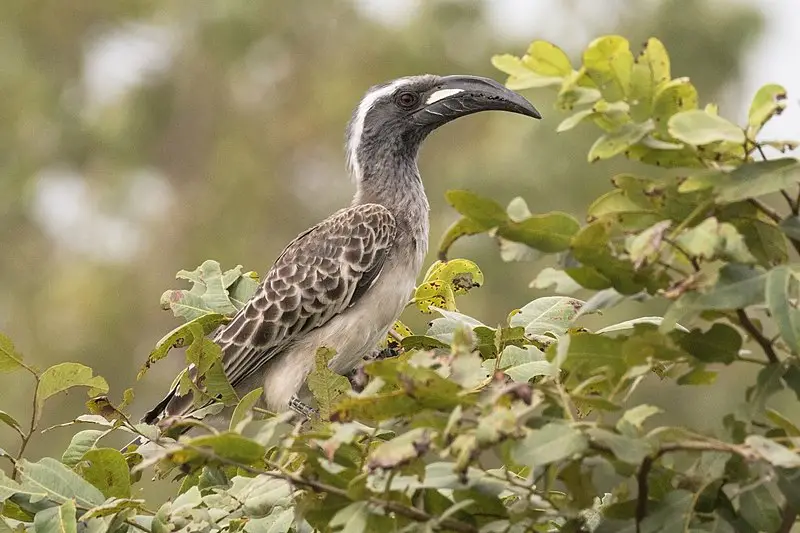
The African grey hornbill is a large bird with striking black and white plumage. Its most recognizable feature is its long, down-curved bill which has a red base and yellow tip.
They are found in sub-Saharan Africa as well as Arabia and have been known to escape or be released into Florida where they may not be breeding yet.
Their diet mainly consists of fruits, insects, small reptiles and amphibians making them important seed dispersers for their habitats.
Hornbills play an important role in the ecosystem by controlling pests like locusts while also providing food for predators such as eagles or larger cats.
These birds are often kept as pets but can become very demanding due to their intelligence so potential owners should do research before considering one of these amazing creatures.Scientific classification:
| Kingdom | Animalia |
| Phylum | Chordata |
| Class | Aves |
| Order | Bucerotiformes |
| Family | Bucerotidae |
| Genus | Lophoceros |
| Species | L. nasutus |
Also Featured In: Common Nigerian Birds, Birds that You’ll Find in Kruger national park
2. Kori Bustard
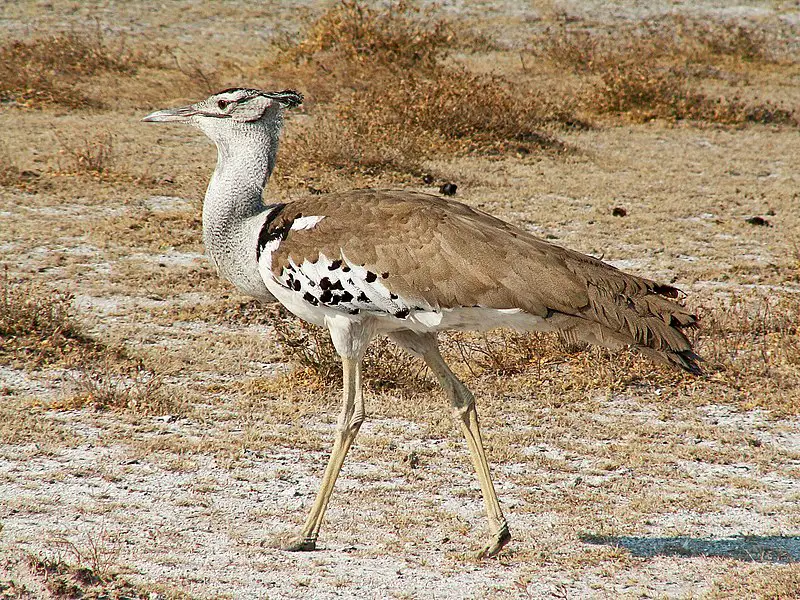
The Kori Bustard is the largest flying bird native to Africa and part of the bustard family. It has a large body, with males reaching up to 20kg in weight – making it one of the heaviest living animals capable of flight.
Its range covers most African countries from Ethiopia all the way down south towards South Africa.
The Kori Bustard is omnivorous and feeds on insects, small lizards, seeds, fruit and even carrion if available.
Their feathers are mostly brownish grey while their heads have black stripes running over them which makes them easily identifiable when seen in its natural habitat.
They usually live alone or in pairs during breeding season but will gather into larger groups at other times throughout their lives; typically nesting on dry open grasslands near water sources for easy access to food and drink.Scientific classification:
| Kingdom | Animalia |
| Phylum | Chordata |
| Class | Aves |
| Order | Otidiformes |
| Family | Otididae |
| Genus | Ardeotis |
| Species | A. kori |
Also Featured In: Birds of Tanzania, African Birds
3. Blacksmith Lapwing
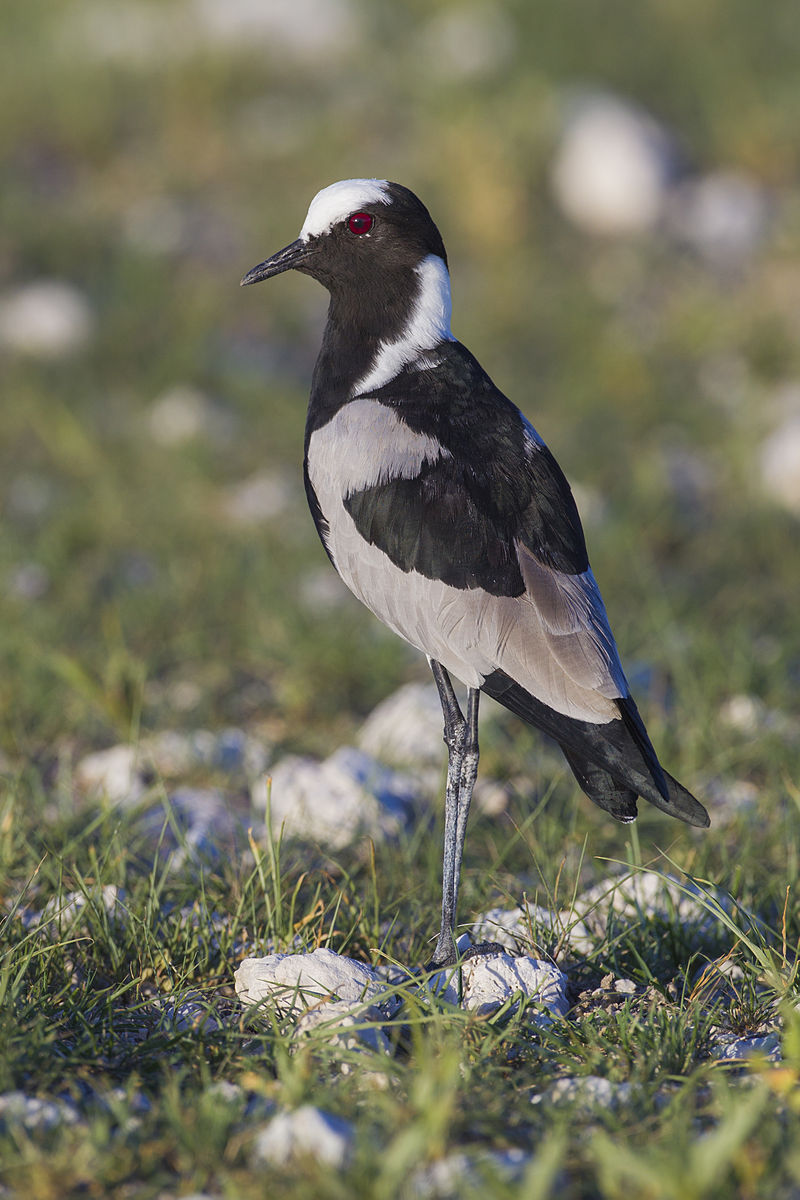
The Blacksmith lapwing is a bird that has an unique appearance with black, grey and white colors. It can be found in Kenya through central Tanzania to south Africa.
The name of the species comes from its alarm call which resembles the sound of a blacksmith striking an anvil – “tink, tink, tink.”.
These birds are quite common but their numbers have been declining due to habitat destruction caused by human activities such as urbanization and agriculture expansion.
They build nests on open ground like grasslands or scrubland near water sources where they feed on insects and small invertebrates while also being preyed upon by larger animals like mongooses or snakes.
Conservation efforts must be taken in order protect these beautiful creatures so future generations can admire them too.Scientific classification:
| Kingdom | Animalia |
| Phylum | Chordata |
| Class | Aves |
| Order | Charadriiformes |
| Family | Charadriidae |
| Genus | Vanellus |
| Species | V. armatus |
4. Diederik Cuckoo
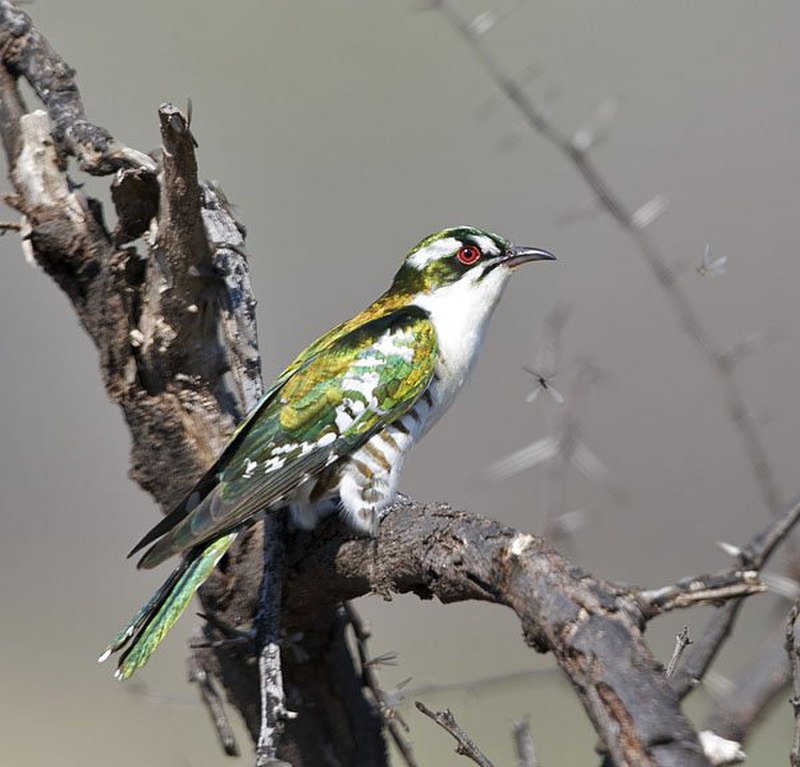
The Diederik Cuckoo is a small and beautiful bird native to the Cape of Good Hope region in South Africa. It has an attractive plumage with black, white and grey feathers covering its body.
Its flight is agile as it soars through the air gracefully on long wings.
The species gets its name from Dutch colonialist Jan van Riebeeck who named it after his friend Diederik Westerwoltz when they encountered one together in 1662 near Table Bay.
This cuckoo prefers open woodlands where they can find their preferred food items like grasshoppers, crickets and caterpillars among others.
They are also known for laying eggs in other birds’ nests which leads to them being adopted by these unsuspecting hosts unknowingly.Scientific classification:
| Kingdom | Animalia |
| Phylum | Chordata |
| Class | Aves |
| Order | Cuculiformes |
| Family | Cuculidae |
| Genus | Chrysococcyx |
| Species | C. caprius |
Also Featured In: Birds of South African,
5. Southern Yellow-Billed Hornbill
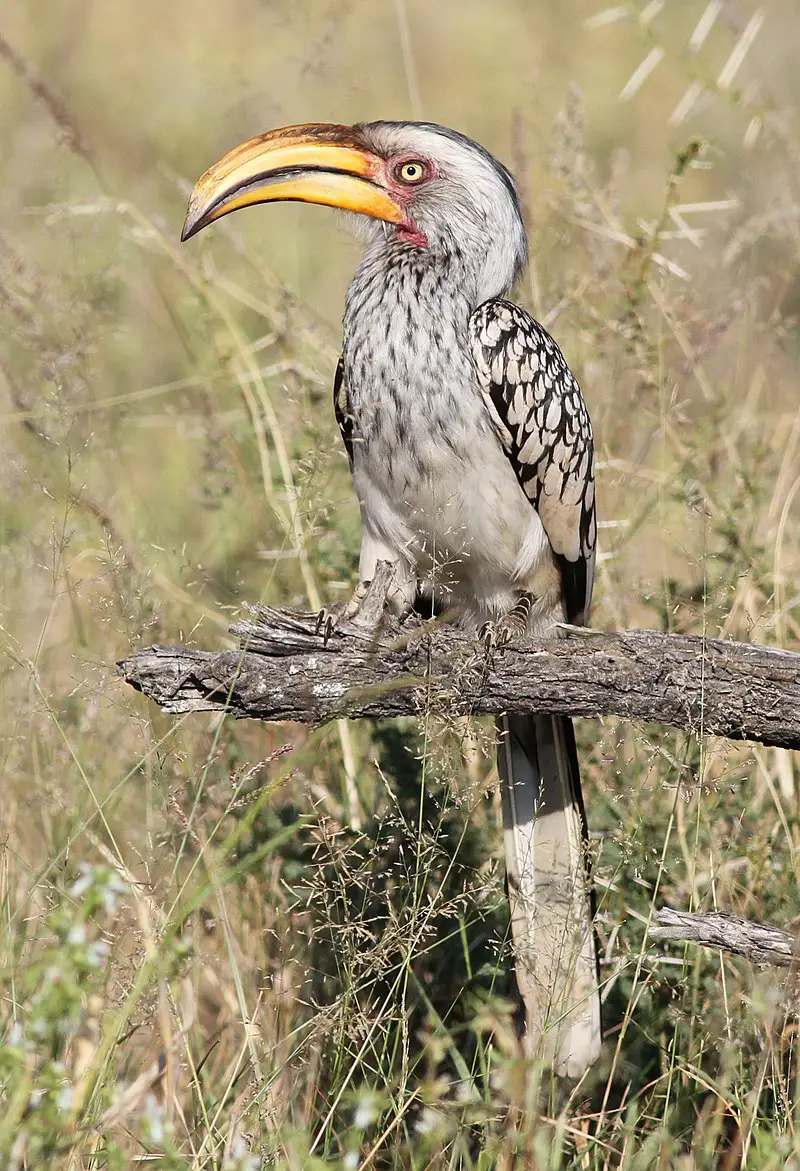
The Southern yellow-billed hornbill is a species of medium sized bird found in southern Africa. It feeds mainly on the ground, foraging for seeds, insects, spiders and scorpions.
These birds are quite common and can be seen along roadsides and water courses due to their preference of dry thornveldt as well as broad-leafed woodlands.
They have bright yellow bills which make them easily recognizable among other birds.
The average length of these beautiful creatures range between 40 – 48 cm with an impressive wingspan reaching up to 90 cm wide.
This stunning species is considered vulnerable by IUCN since it’s numbers are slowly declining due to hunting activities and habitat destruction from urbanization.Scientific classification:
| Kingdom | Animalia |
| Phylum | Chordata |
| Class | Aves |
| Order | Bucerotiformes |
| Family | Bucerotidae |
| Genus | Tockus |
| Species | T. leucomelas |
Also Featured In: Savanna Birds You Need to See, Birds You’ll Find in Kenya Safari
6. Namaqua Sandgrouse
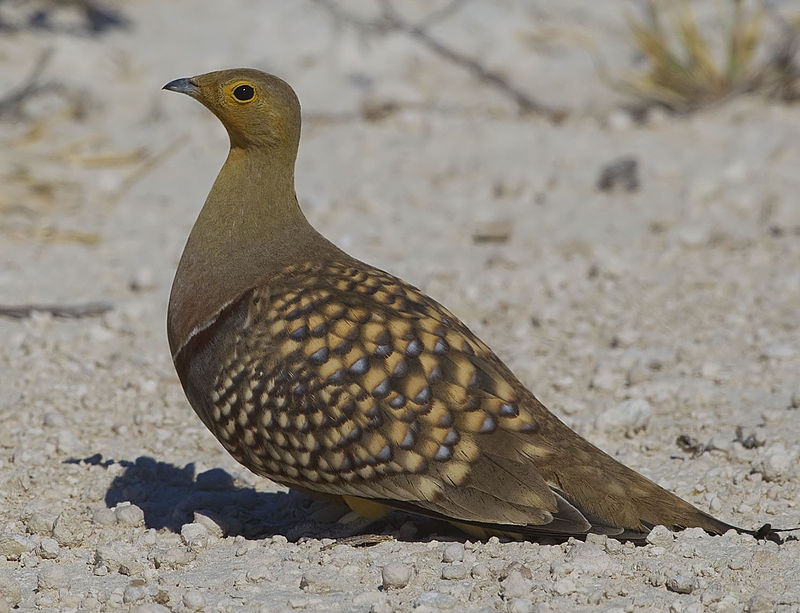
The Namaqua sandgrouse is a species of ground-dwelling bird belonging to the sandgrouse family.
It inhabits arid regions in south-western Africa and was formally described by German naturalist Johann Friedrich Gmelin in 1789 as part of his revised edition of Carl Linnaeus’ Systema Naturae.
Featuring a mottled buff, grey and brown plumage, it has black markings on its wings that help distinguish it from other birds within its range.
The male also displays an eye comb, which consists of two rows of upright feathers forming lengthy tufts around the eyes.
They feed mainly on seeds but will supplement their diet with insects if available during times when food is scarce.
During breeding season they form monogamous pairs who share incubation duties for up to four eggs per clutch before raising them together until they are ready to fledge at approximately 30 days old.Scientific classification:
| Kingdom | Animalia |
| Phylum | Chordata |
| Class | Aves |
| Order | Pterocliformes |
| Family | Pteroclidae |
| Genus | Pterocles |
| Species | P. namaqua |
7. Northern Black Korhaan
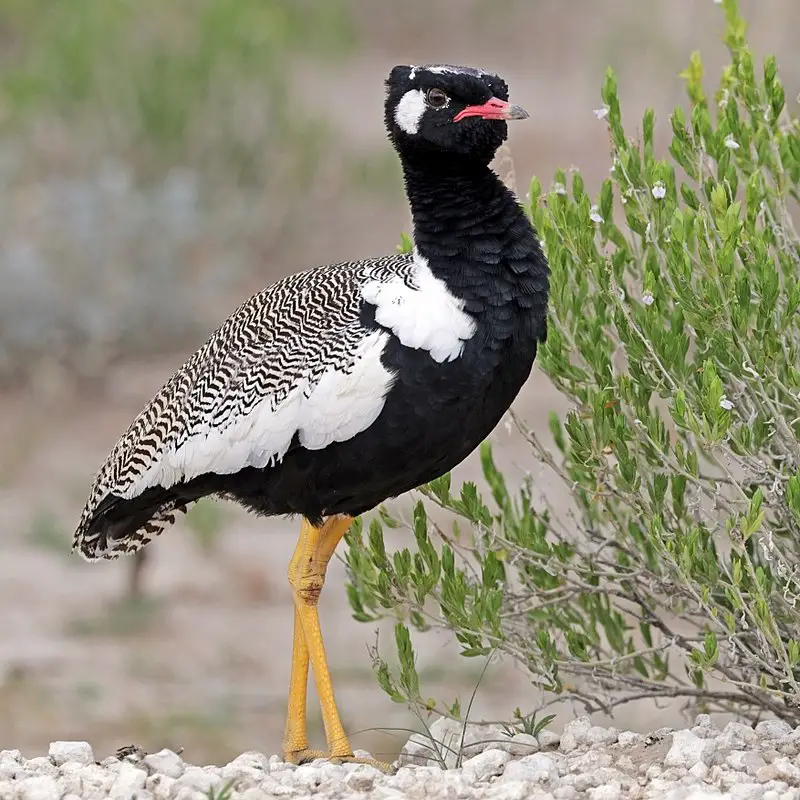
The Northern Black Korhaan, or White-Quilled Bustard, is an impressive bird found across Southern Africa. This species of bustard is highly adapted to open grasslands and scrubland habitats.
It was first discovered by Andrew Smith in 1831 and given the scientific name “afrao”.
The appearance of these birds can vary greatly depending on where they are located; some feature a distinctive white head plume while others have black feathers that cover their whole bodies.
They also tend to be quite large with wingspans reaching up to 42 inches long. These majestic creatures play important roles in their ecosystems as both predators and prey for other animals.
Despite all this beauty, sadly populations have been declining due to human activities such as habitat destruction and hunting pressure from poachers.
With conservation efforts we hope that the future looks brighter for these amazing birds.Scientific classification:
| Kingdom | Animalia |
| Phylum | Chordata |
| Class | Aves |
| Order | Otidiformes |
| Family | Otididae |
| Genus | Afrotis |
| Species | A. afraoides |
8. Cardinal Woodpecker
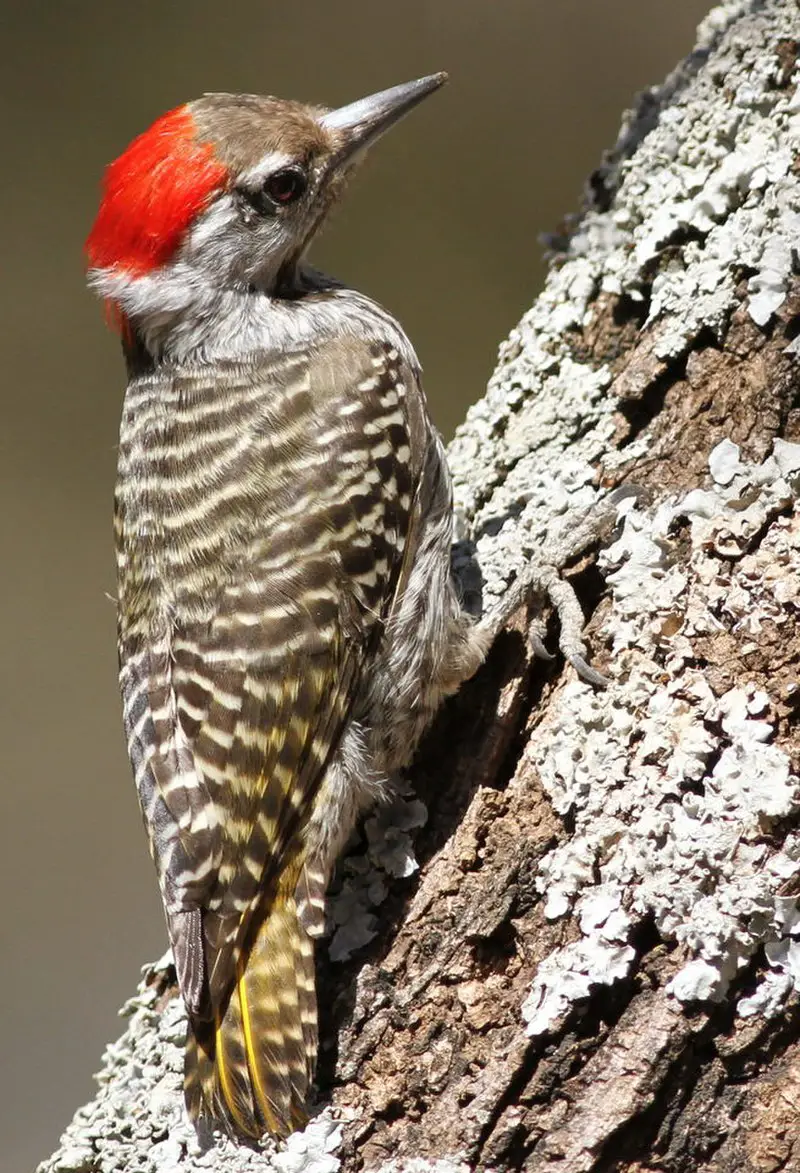
The Cardinal Woodpecker is a widespread and common resident found in much of sub-Saharan Africa. It inhabits various habitats, from dense forests to thorny bushlands, making it quite adaptable.
This species can be identified by its distinctive call notes as well as the difference between males and females which are distinguishable through their head patterns.
The bird was first described in 1818 by French ornithologist Louis Pierre Vieillot who recognized this unique species among other woodpeckers that inhabit the same region.
Despite being so widely spread throughout Africa, little is known about its behavior or population size due to lack of research on the subject – something that should surely change going forward.Scientific classification:
| Kingdom | Animalia |
| Phylum | Chordata |
| Class | Aves |
| Order | Piciformes |
| Family | Picidae |
| Genus | Dendropicos |
| Species | D. fuscescens |
Also Featured In: Top Birds of Rwanda,
9. Caspian Plover
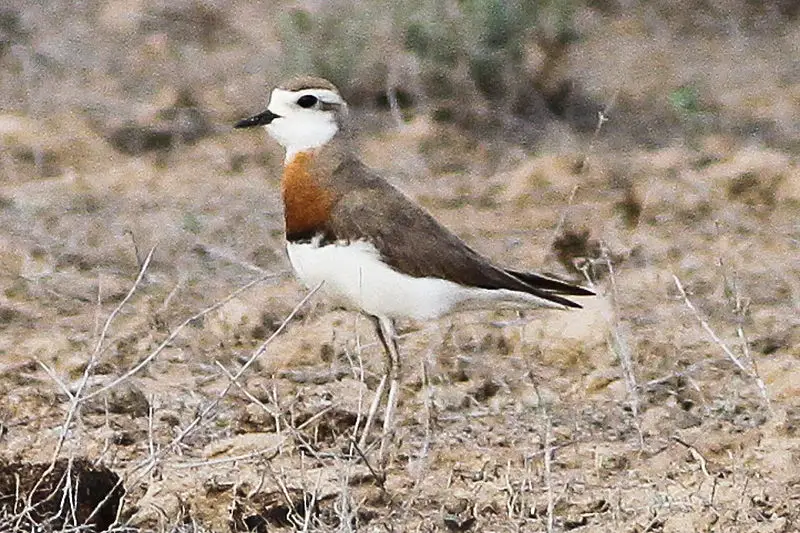
The Caspian plover is a species of wader belonging to the plover family of birds. It has an apt scientific name as ‘Charadrius’ meaning yellowish bird and ‘asiaticus’ referring to its Asian range.
These birds are found in ravines, river valleys or coastal mudflats with their diet primarily consisting of insects, crustaceans and worms.
They breed once every year producing 4-5 eggs which they incubate for around 25 days before hatching into chicks that fledge after another couple weeks.
The IUCN Red List classifies them as Vulnerable due to human activities like hunting and wetland reclamation leading to habitat destruction causing population decline over time.
Conservation efforts need be undertaken soon in order ensure survival of this beautiful species.Scientific classification:
| Kingdom | Animalia |
| Phylum | Chordata |
| Class | Aves |
| Order | Charadriiformes |
| Family | Charadriidae |
| Genus | Charadrius |
| Species | C. asiaticus |
Also Featured In: Qatar birds,
10. Bare-Cheeked Babbler
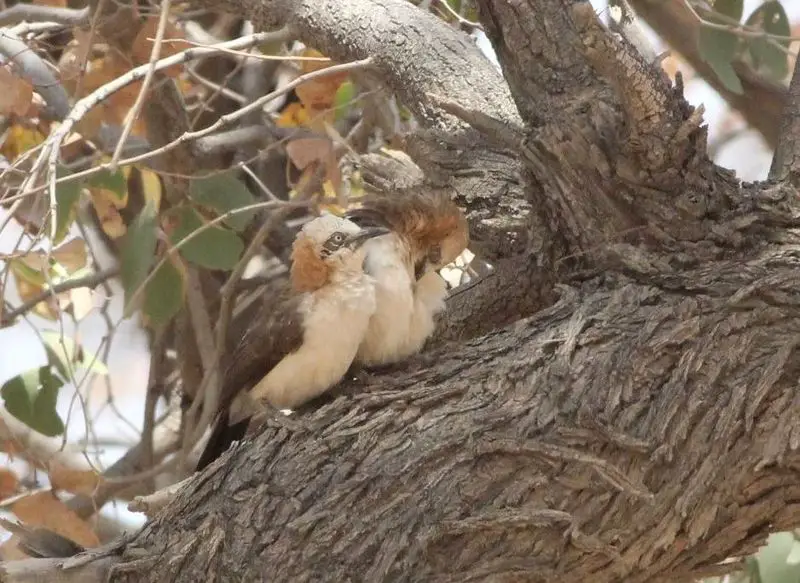
The Bare-cheeked babbler is a species of bird that can be found in Angola and Namibia. It has greyish or olive-brown plumage with white on its wings, throat, and cheeks; hence the name “Bare-cheeked”.
This bird prefers to live in dry forest areas or shrubland habitats where it will feed mainly on insects, but also some fruits and seeds if available.
Due to their large home range these birds are often seen alone rather than in flocks like many other birds.
They have been known to travel up to 27km per day foraging for food which makes them quite an active species.
Sadly this beautiful bird is listed as Near Threatened due mostly from habitat loss due human activities such as agriculture expansion and livestock grazing reducing the amount of suitable environments available for them.Scientific classification:
| Kingdom | Animalia |
| Phylum | Chordata |
| Class | Aves |
| Order | Passeriformes |
| Family | Leiothrichidae |
| Genus | Turdoides |
| Species | T. gymnogenys |
Also Featured In: Namibia birds,
11. Monteiro’s Hornbill
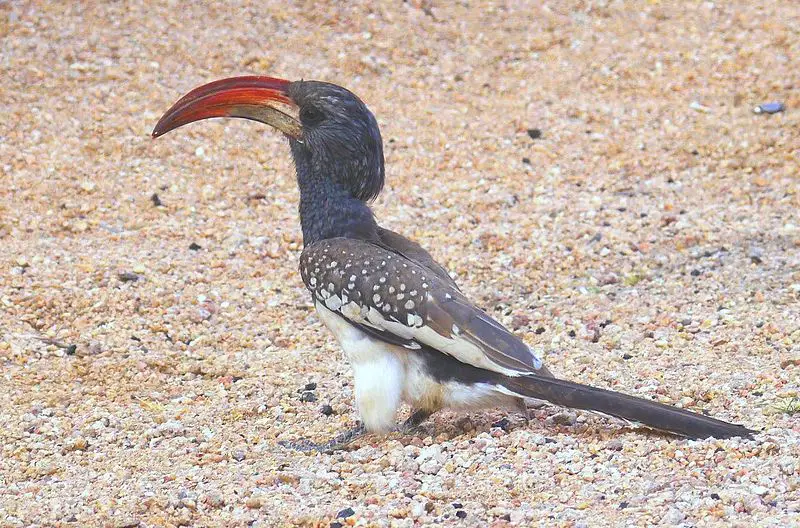
Monteiro’s hornbill is a species of large, striking bird that inhabits the dry woodlands of southwestern Africa.
It has an impressive length of 54-58 cm and weighs between 210 – 400g, making it one of the biggest members in its family.
This near-endemic species can be found predominantly in Namibia where their population stands at around 340,000 individuals.
They have a blackish body with white eyespots on each side; males also feature an orange throat patch which females lack.
With their iconic curved bill and loud call they are easily recognisable yet remain elusive to most people due to their remote habitats away from civilisation.Scientific classification:
| Kingdom | Animalia |
| Phylum | Chordata |
| Class | Aves |
| Order | Bucerotiformes |
| Family | Bucerotidae |
| Genus | Tockus |
| Species | T. monteiri |
12. Golden-Tailed Woodpecker
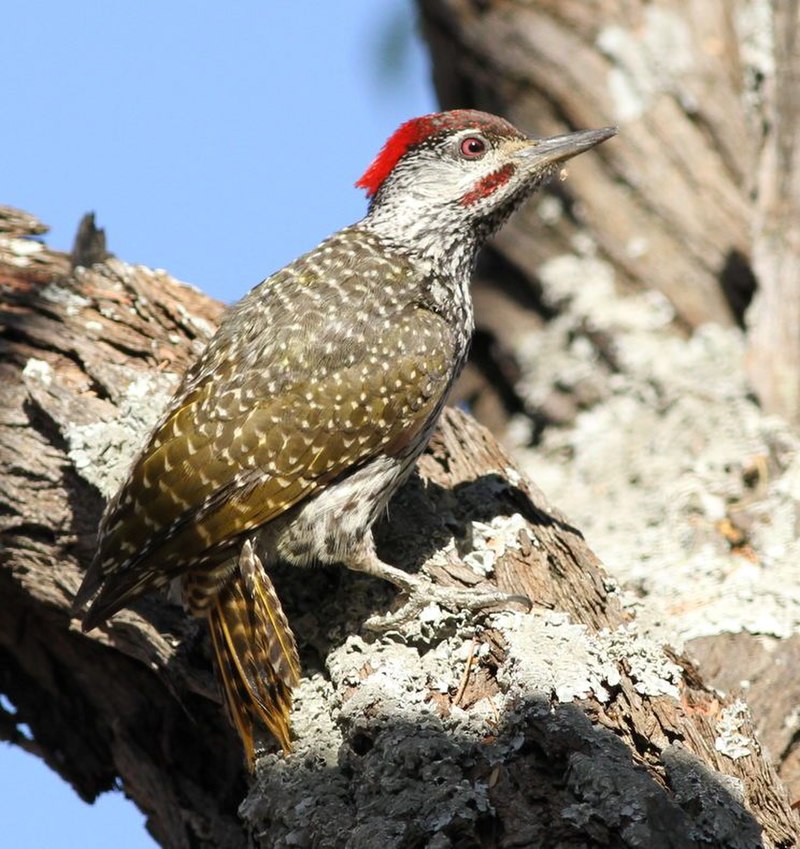
The golden-tailed woodpecker is a beautiful species of bird belonging to the Picidae family. It is named after the 5th Earl of Abingdon and has a gorgeous combination of barred, greenish upper parts.
This species can be found in central Africa from southern Sudan to northern Angola and Zambia. Its range also extends southwards through eastern Democratic Republic of Congo into Uganda, Kenya and Tanzania.
Golden-tailed woodpeckers are usually solitary birds which feed on insects by hammering at tree bark with their strong bills for food such as larvae or pupae that live under the bark surface.
They may also eat fruit when it’s available seasonally but will rarely congregate together except during breeding seasons when they pair off for nesting purposes in cavities excavated from trees like other members of its family do too.Scientific classification:
| Kingdom | Animalia |
| Phylum | Chordata |
| Class | Aves |
| Order | Piciformes |
| Family | Picidae |
| Genus | Campethera |
| Species | C. abingoni |
13. Violet Wood Hoopoe
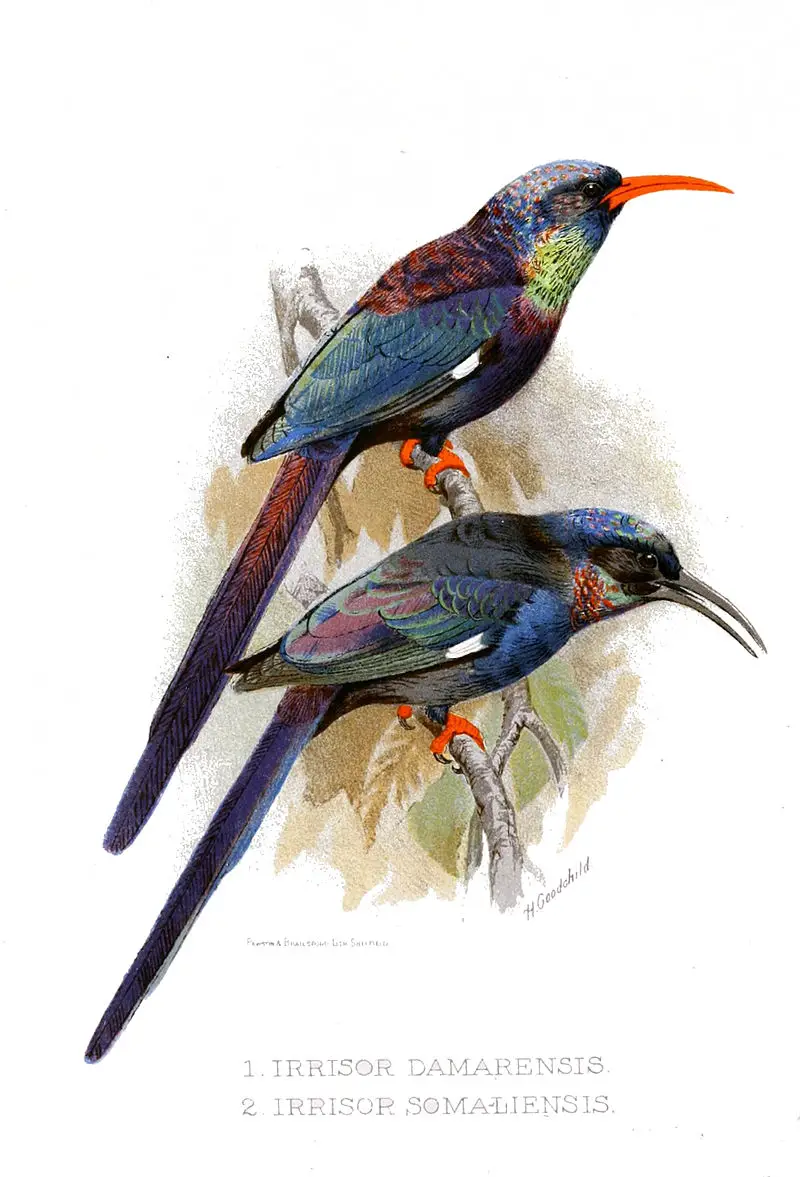
The Violet wood hoopoe is a large, colorful bird found in Angola, Kenya, Namibia and Tanzania. It has an unmistakable plumage of violet-blue feathers on its wings and tail with black markings along the edges.
Its head is adorned with a red beak and green throat patch that stands out against its otherwise dark body. It also sports striking white stripes around each eye for added contrast.
Grant’s wood hoopoe (P. d granti) may sometimes be considered as a distinct species due to slight differences in their appearance such as bill coloration or patterning variations on the neck region; however more research needs to be done before confirming this status change officially.
The diet of these birds consists mainly of insects which they find by probing into tree bark or soil crevices while searching for food sources during flight or while perched atop branches high up in trees.Scientific classification:
| Kingdom | Animalia |
| Phylum | Chordata |
| Class | Aves |
| Order | Bucerotiformes |
| Family | Phoeniculidae |
| Genus | Phoeniculus |
| Species | P. damarensis |
14. African Cuckoo
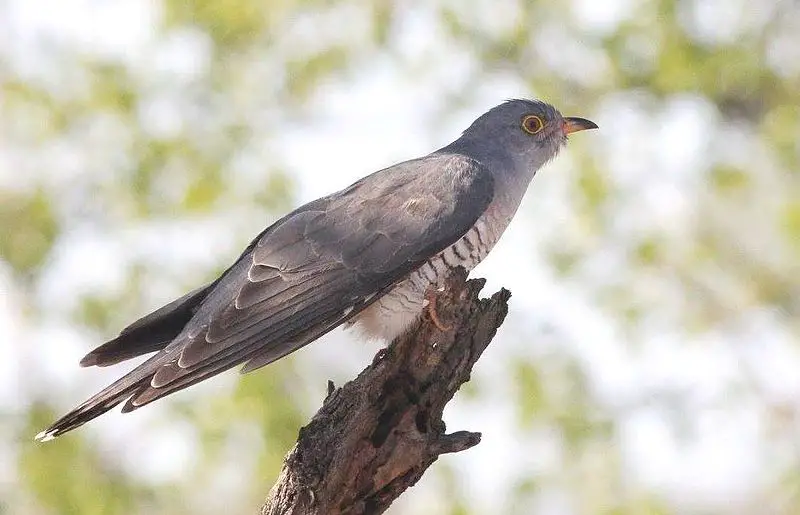
The African cuckoo is an easily recognizable species of bird belonging to the Cuculidae family. With its distinct plumage and call, it can be found in Sub-Saharan Africa, where it migrates seasonally.
During the rainy season they arrive in their breeding grounds ready to lay eggs in other birds’ nests as part of their nesting habits.
They are fairly common across much of Africa and have a conservation status rated as ‘least concern’ by the International Union for Conservation of Nature (IUCN).
The African cuckoo is medium sized with long tail feathers which provide them with excellent maneuverability while flying or perching on trees.
Its diet consists mainly insects such as caterpillars and dragonflies but sometimes also includes fruits or small reptiles if available.Scientific classification:
| Kingdom | Animalia |
| Phylum | Chordata |
| Class | Aves |
| Order | Cuculiformes |
| Family | Cuculidae |
| Genus | Cuculus |
| Species | C. gularis |
15. Carp’s Tit
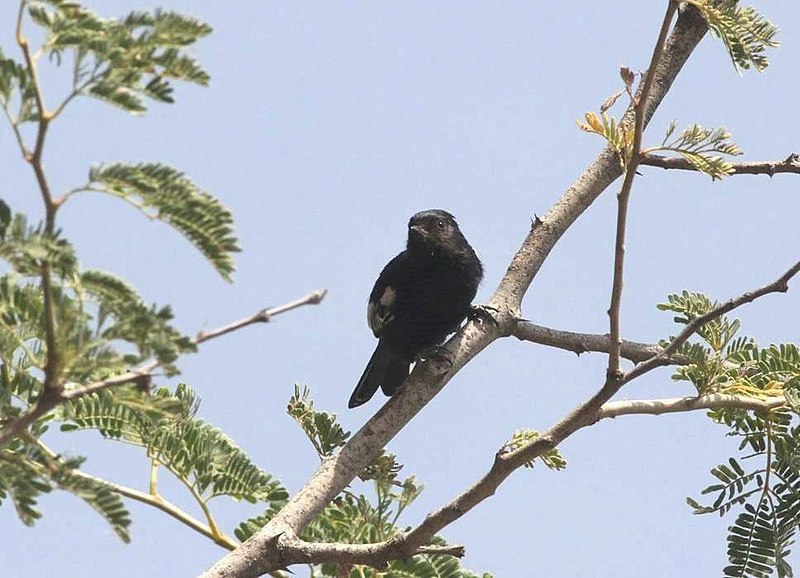
Carp’s tit is a species of bird found in the Namibian and southern Angolan savanna woodlands. It is also known as Carp’s black tit, or sometimes considered to be a subspecies of the black tit.
This species was named after olympic sailor and ornithologist Berend Carp (1901-1966). The Carp’s Tit belongs to the family Paridae, which used to include many other species within its genus Parus.
These birds are usually quite small with brownish gray feathers on their heads, back, wings and tails; they have white bellies with some yellow patches around them too.
They mainly feed on insects but will take advantage of any food source available such as seeds or fruits when necessary.
All in all these birds make for an interesting sight while living in their habitat – so keep your eyes peeled if you’re ever out there.Scientific classification:
| Kingdom | Animalia |
| Phylum | Chordata |
| Class | Aves |
| Order | Passeriformes |
| Family | Paridae |
| Genus | Melaniparus |
| Species | M. carpi |
16. Pale Chanting Goshawk
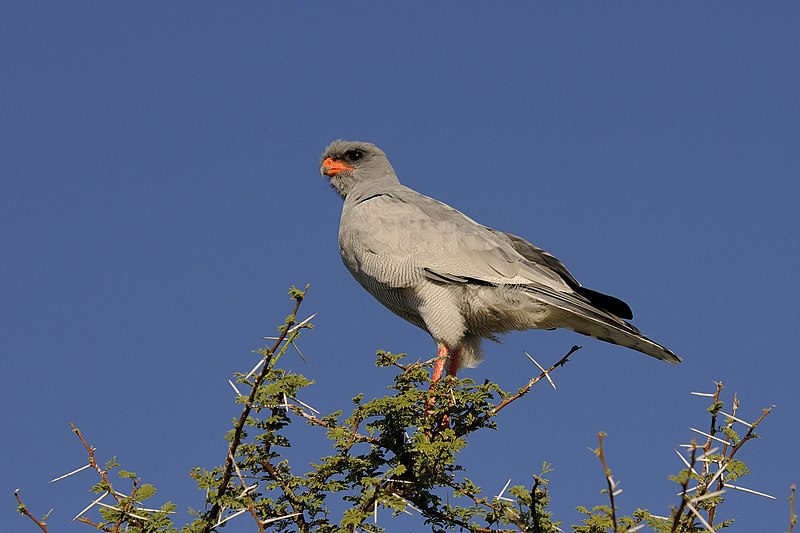
The Pale Chanting Goshawk is a bird of prey found in southern Africa. It typically resides in dry, semi-desert areas with an annual rainfall of 75cm or less.
At 55 cm long and with a wingspan of 110 cm, it is easily spotted perched on telephone poles due to its grey upperparts and white rump.
Its diet consists mainly of small mammals such as rodents but can also include reptiles, birds and insects.
The female lays 2-3 eggs which are incubated by both parents for around 4 weeks before hatching into chicks that will fledge the nest after five weeks or so.
This species plays an important role in controlling populations of small animals like mice and rats while providing great opportunities for bird watchers to observe them during their breeding season from October through December each year.Scientific classification:
| Kingdom | Animalia |
| Phylum | Chordata |
| Class | Aves |
| Order | Accipitriformes |
| Family | Accipitridae |
| Genus | Melierax |
| Species | M. canorus |
17. Red-Billed Spurfowl
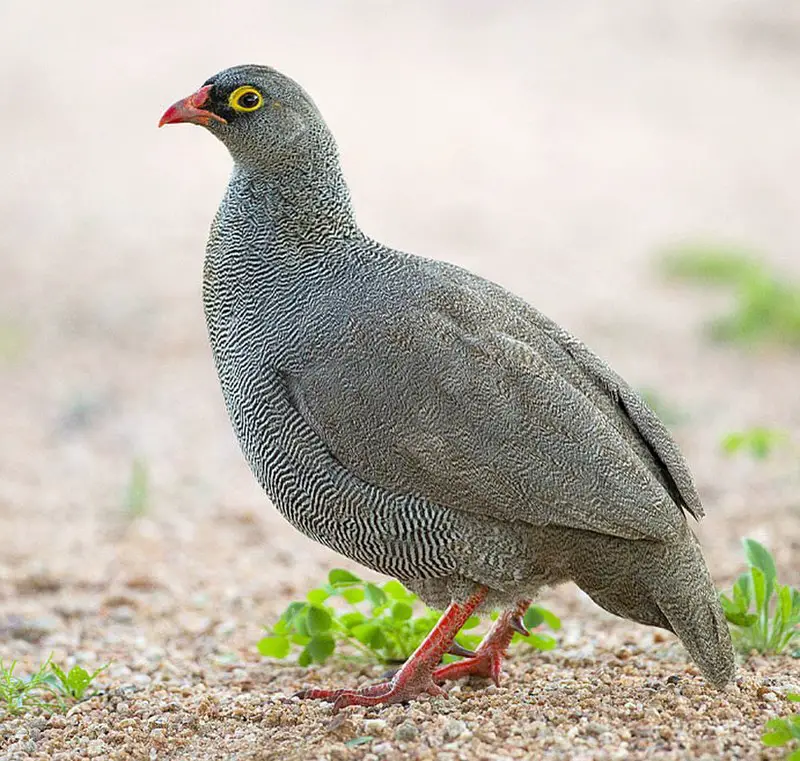
The red-billed spurfowl is a species of bird found in Southern Africa. It has distinctive plumage, characterized by its bright red bill and brownish patches on the chest and back.
Males are larger than females, measuring 38 cm long with weights ranging from 340 to 635 g.
This species exhibits sexual dimorphism in size as well as coloration; males are darker than females with black bars across their wings while females have lighter colored stripes instead.
Their diet consists mainly of seeds and insects, but they will also eat small reptiles or amphibians when available.
They can be seen foraging around farmlands or grassy areas near water sources such as rivers or streams during the day time hours.
The Red-billed Spurfowl is an important food source for many predators due to its abundance throughout much of South Africa’s habitat range that make it easily accessible prey item for hunting animals like snakes, birds of prey and even large cats such as leopards.Scientific classification:
| Kingdom | Animalia |
| Phylum | Chordata |
| Class | Aves |
| Order | Galliformes |
| Family | Phasianidae |
| Genus | Pternistis |
| Species | P. adspersus |
Also Featured In: Botswana birds,
18. African Red-Eyed Bulbul
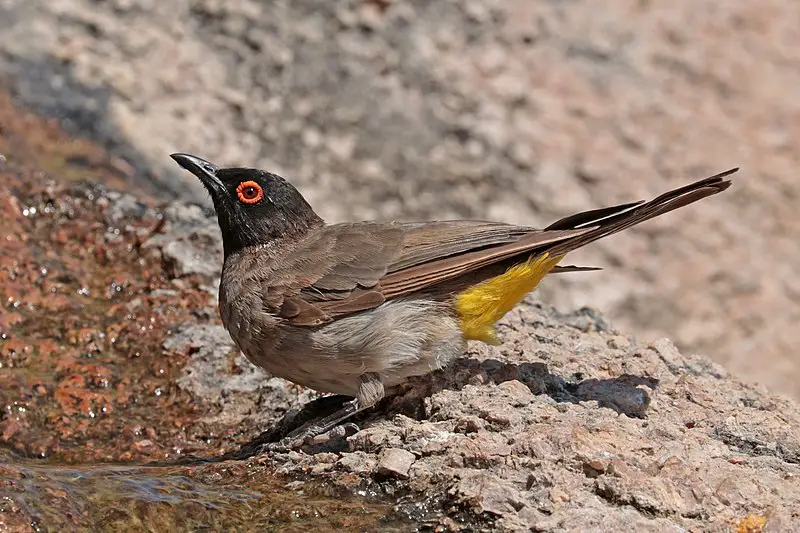
The African red-eyed bulbul is a species of songbird found in south-western Africa. It has black feathers on its front and reddish-brown plumage across the rest of its body, giving it an eye catching appearance.
The bird feeds mainly off fruit, flowers, nectar and insects which makes them omnivorous creatures that are easy to spot around their natural habitats such as dry savannas, subtropical or tropical dry shrubland and riverine scrublands.
They have an average length between 19 – 21 centimeters making them relatively small birds compared to some other species in the Pycnonotidae family but they make up for this with their strong vocal abilities.
Their distinct call can be heard from far distances which adds greatly to the charm of these beautiful birds.Scientific classification:
| Kingdom | Animalia |
| Phylum | Chordata |
| Class | Aves |
| Order | Passeriformes |
| Family | Pycnonotidae |
| Genus | Pycnonotus |
| Species | P. nigricans |
Also Featured In: Lesotho birds,
19. Cape Starling
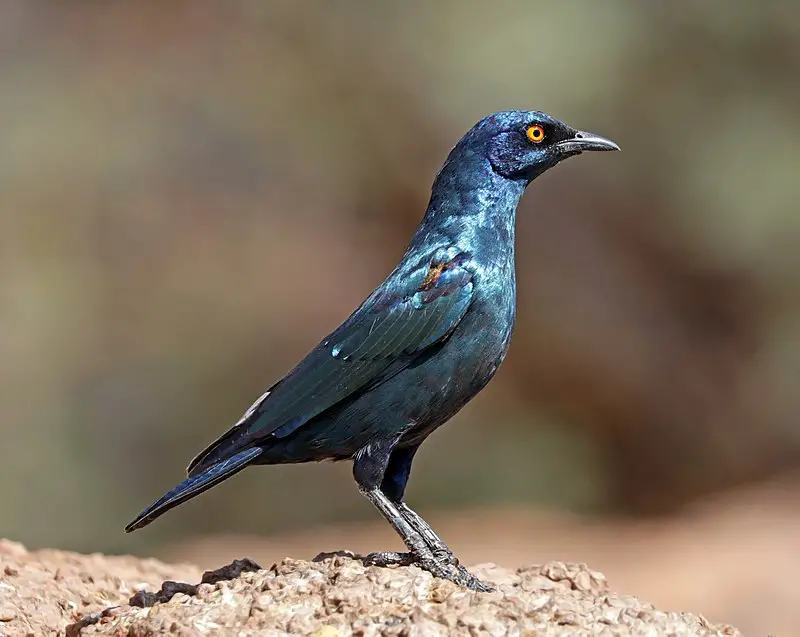
The Cape starling is a species of starling native to Southern Africa, living in woodlands, bushveld and even suburbs. It has two subspecies; the larger ‘L. n. culminator’ having greener wings and tail plumage than its counterpart.
These birds are mainly grey in colour with white spots on their bodies and bright red eyes which make them stand out from other similar-looking species found in the region.
They have long bills for picking up food items such as insects, seeds or berries along with powerful legs for perching upon trees or wires alike – an important trait when it comes to finding shelter during bad weather.
The males also have glossy black heads while females possess pale brown ones; both sexes share common yellow beaks making this bird a beautiful sight indeed.Scientific classification:
| Kingdom | Animalia |
| Phylum | Chordata |
| Class | Aves |
| Order | Passeriformes |
| Family | Sturnidae |
| Genus | Lamprotornis |
| Species | L. nitens |
20. Greater Kestrel
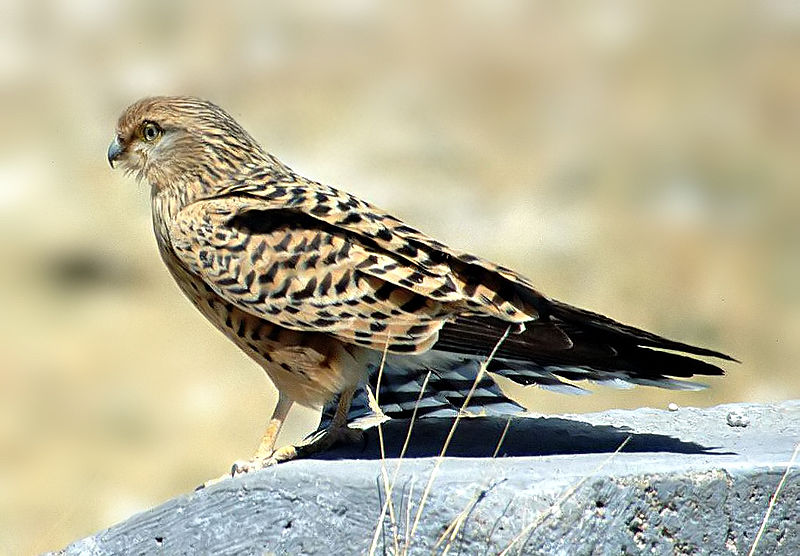
The Greater Kestrel, a large bird of prey from the Falconidae family, is found in open country throughout southern and eastern Africa.
It has mainly pale rufous plumage above and below with black barring on its back, upperwing and flanks.
Its breast has dark streaks while its head is streaked buff-brown with white eyes – hence it’s name; White-eyed Kestrel.
These birds are primarily carnivorous eating small mammals such as rodents, lizards or insects which they catch either by hovering high up or perched atop tall trees.
They also take advantage of human settlements to supplement their diet when food becomes scarce during harsher seasons.
Historically these birds were used for falconry but now they are increasingly threatened due to habitat loss caused by humans across their range making conservation efforts all the more important if we wish to ensure this majestic species will continue flying our skies for generations to come.Scientific classification:
| Kingdom | Animalia |
| Phylum | Chordata |
| Class | Aves |
| Order | Falconiformes |
| Family | Falconidae |
| Genus | Falco |
| Species | F. rupicoloides |
21. Lesser Masked Weaver
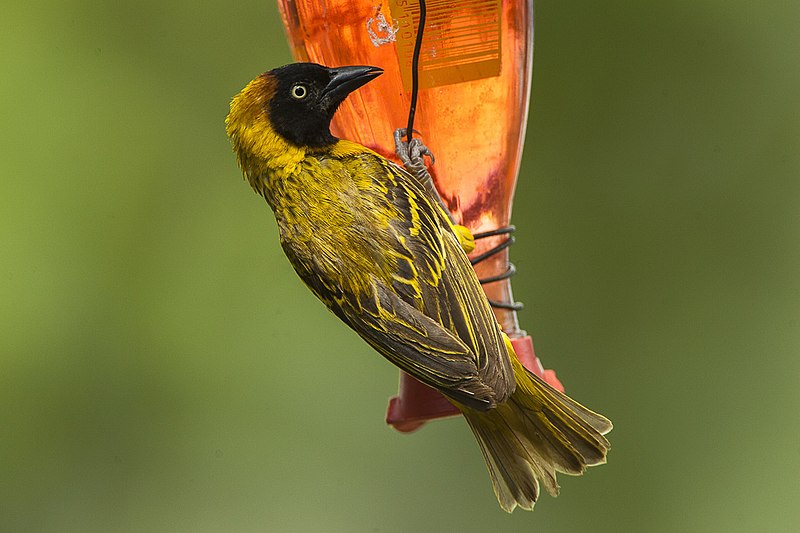
The Lesser Masked Weaver is a species of bird found in eastern, south-eastern and southern Africa.
It has two different subspecies which build their nests in large colonies often alongside the Village Weaver and sometimes Red-billed Buffalo Weavers.
These birds are commonly parasitised by Diederik Cuckoos due to its habit of nesting close together with other weaver families.
The male weavers have bright yellow feathers on their heads along with black eyes while the females have brownish plumage that helps them blend into their environment better for protection from predators.
They feed mainly on insects, seeds, berries and flower buds but can also take advantage of human sources such as agricultural fields or garden vegetation when available nearby.
Overall this small yet vibrant bird brings life to any area it inhabits making it an almost universally loved avian friend.Scientific classification:
| Kingdom | Animalia |
| Phylum | Chordata |
| Class | Aves |
| Order | Passeriformes |
| Family | Ploceidae |
| Genus | Ploceus |
| Species | P. intermedius |
Also Featured In: Djibouti birds,
22. Fork-Tailed Drongo
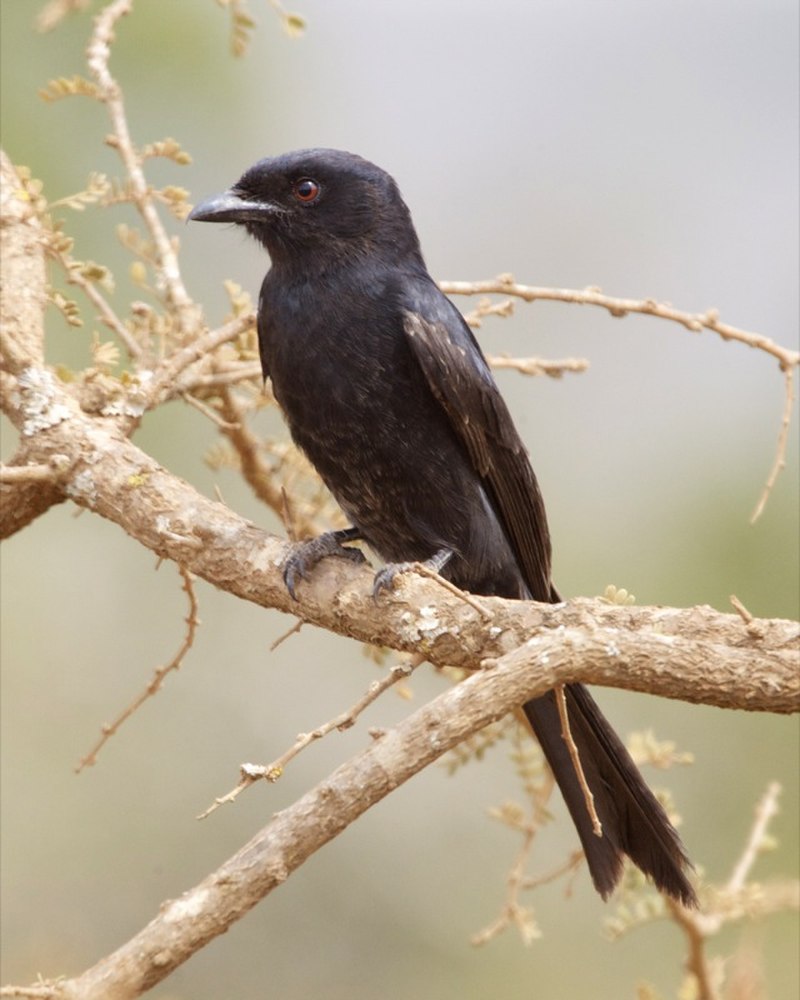
The fork-tailed drongo, also known as the common drongo or African drongo, is a small passerine bird found across a wide range, from the Sahel to South Africa.
This bird does not inhabit Congolian rainforests or Upper Guinean forests. The species belongs to the family Dicruridae and is characterized by its distinct forked tail.
The fork-tailed drongo has four recognized subspecies. Although small in size, this bird is known for its intelligence and vocal abilities.
The fork-tailed drongo is a skilled mimic and can imitate the calls of other birds to trick them into dropping their prey, which the drongo then swoops in to snatch up for itself.
This bird’s adaptability and cunning make it a fascinating species to observe in its natural habitat.Scientific classification:
| Kingdom | Animalia |
| Phylum | Chordata |
| Class | Aves |
| Order | Passeriformes |
| Family | Dicruridae |
| Genus | Dicrurus |
| Species | D. adsimilis |
Also Featured In: Birds of KwaZulu-Natal,
23. Purple Roller
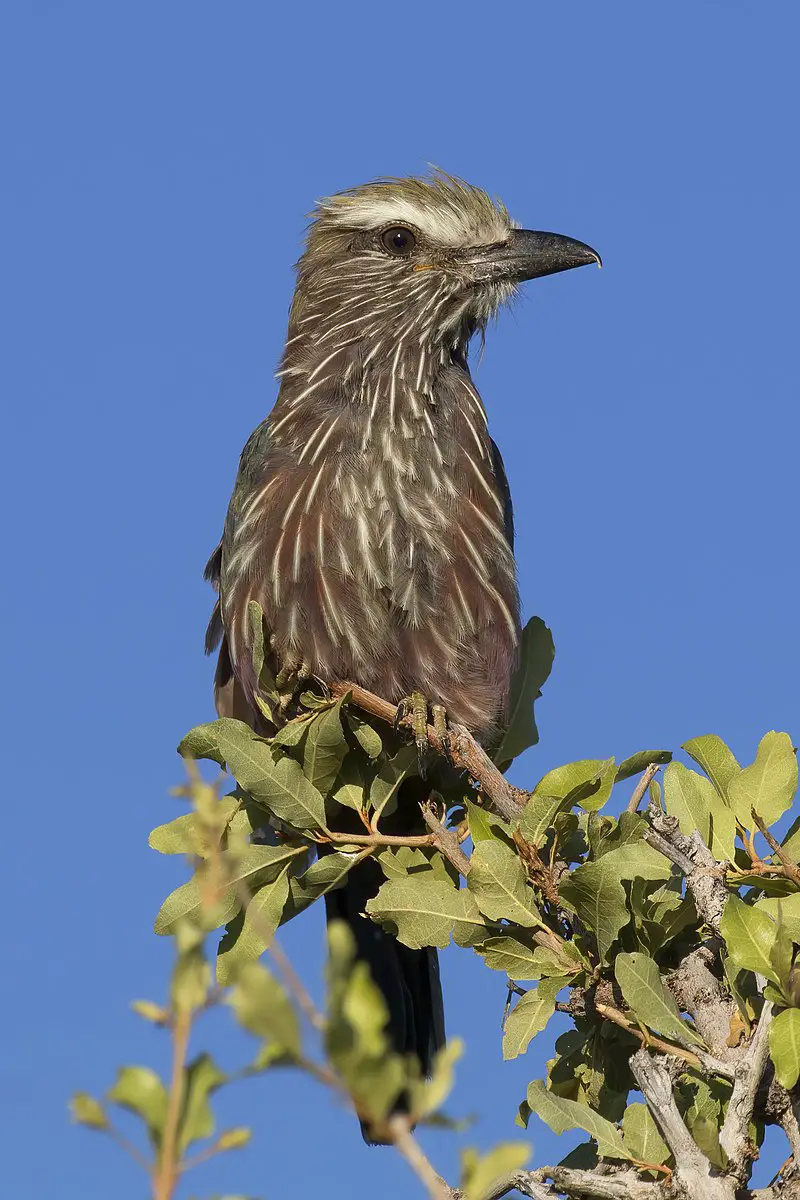
The purple roller, also known as the rufous-crowned roller, is a medium-sized bird found throughout sub-Saharan Africa.
Its appearance is relatively plain compared to other members of the roller family, with dull colors and a harsh, grating voice.
The bird was first described in 1800 by French zoologist François Marie Daudin under the name Coracias naevia, based on a collected specimen.
Despite its unremarkable appearance, the purple roller is a fascinating bird, known for its unique behavior and important role in its ecosystem.
With its widespread distribution, this bird remains an important part of the African avian community.Scientific classification:
| Kingdom | Animalia |
| Phylum | Chordata |
| Class | Aves |
| Order | Coraciiformes |
| Family | Coraciidae |
| Genus | Coracias |
| Species | C. naevius |
24. Cape Crow
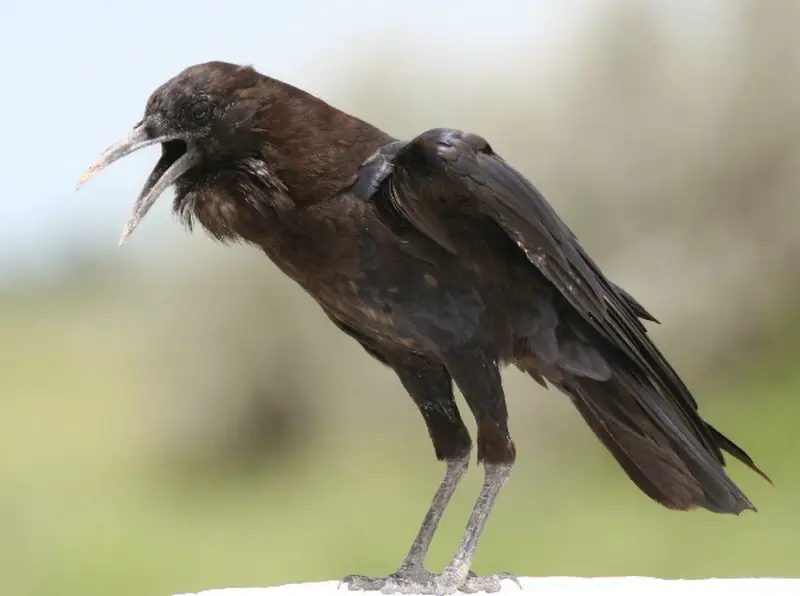
The Cape crow, also known as the black crow, is a bird species that measures around 48-50 cm in length. It is completely black with a subtle purple gloss in its feathers, giving it a regal appearance.
The Cape crow has longer legs, wings, and tail compared to other crow species, and its bill is considerably longer and slimmer, developed to probe the ground for invertebrates. The head feathers of the Cape crow have a coppery-purple gloss.
These birds are known for their intelligence and ability to adapt to new environments. They are commonly found in South Africa, particularly in urban areas where their adaptability has helped them thrive.
Overall, the Cape crow is a striking species with unique physical characteristics and remarkable adaptability.Scientific classification:
| Kingdom | Animalia |
| Phylum | Chordata |
| Class | Aves |
| Order | Passeriformes |
| Family | Corvidae |
| Genus | Corvus |
| Species | C. capensis |
Also Featured In: Scavengers Birds You Should Know, Spiritual Birds
25. Black-Chested Prinia
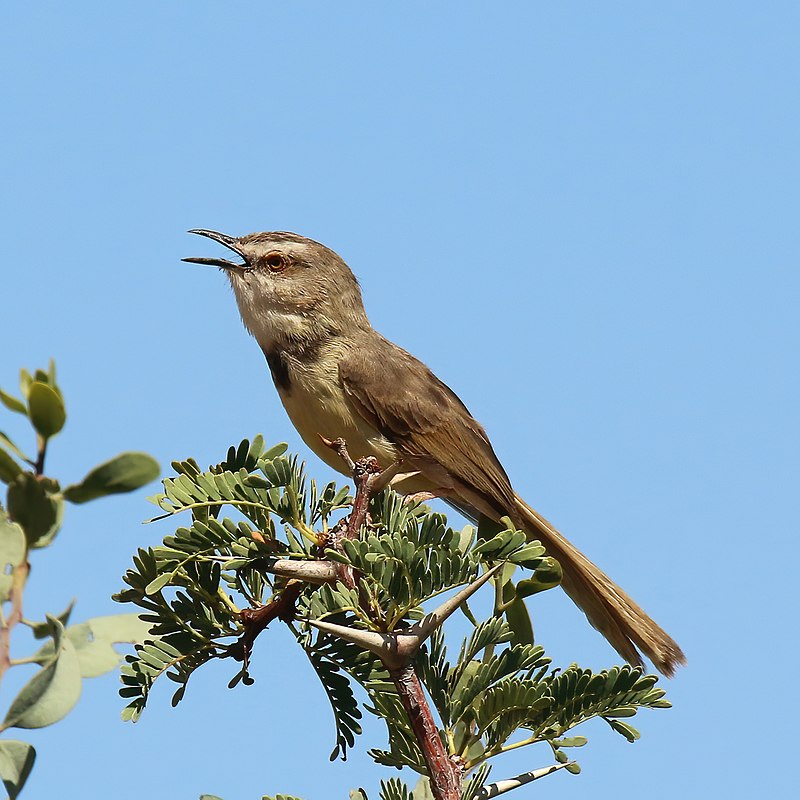
The black-chested prinia is a tiny bird species from the Cisticolidae family. They are found in dry savannas across Angola, Botswana, Lesotho, Namibia, South Africa, Zambia and Zimbabwe.
These birds are characterized by their long tails, which are often held vertically, setting them apart from other warbler species. Unlike other birds, they are sexually monomorphic, meaning there is no difference in appearance between males and females.
Black-chested prinias are small, but they are known for their sweet songs which are often heard in their habitat. They have adapted to the dry savanna, where they continue to thrive.Scientific classification:
| Kingdom | Animalia |
| Phylum | Chordata |
| Class | Aves |
| Order | Passeriformes |
| Family | Cisticolidae |
| Genus | Prinia |
| Species | P. flavicans |
26. Dwarf Bittern
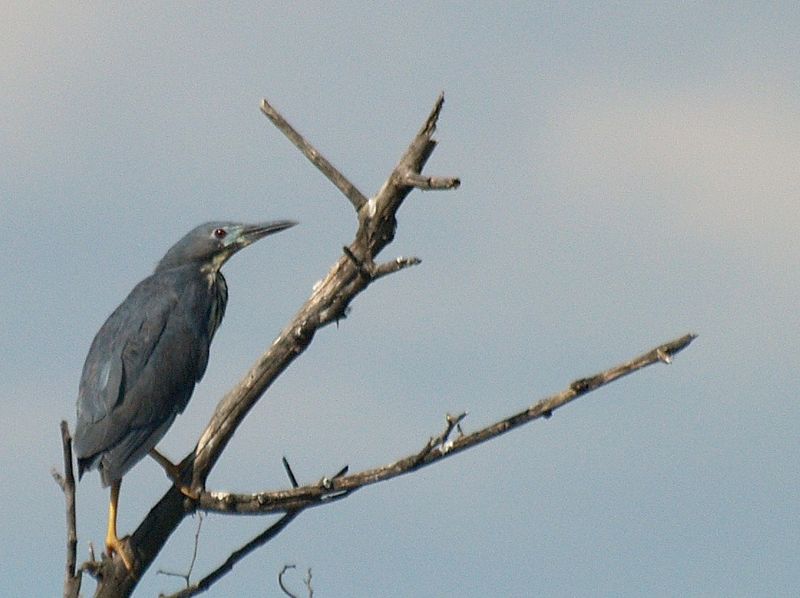
The Dwarf Bittern is a small heron species that belongs to the family Ardeidae. It can be found across a wide range of countries in Africa, including Angola, Ethiopia, and Namibia.
Despite its small size, this bird has a distinctive appearance with a reddish-brown plumage and a black cap on its head. It prefers to inhabit wetland areas, where it feeds on small fish, insects, and amphibians.
The Dwarf Bittern is known for being a solitary bird, and can often be difficult to spot due to its excellent camouflage abilities. Despite this, it is considered to be a species of least concern by the IUCN and is relatively common throughout its range.Scientific classification:
| Kingdom | Animalia |
| Phylum | Chordata |
| Class | Aves |
| Order | Pelecaniformes |
| Family | Ardeidae |
| Genus | Ixobrychus |
| Species | I. sturmii |
27. Short-Toed Rock Thrush
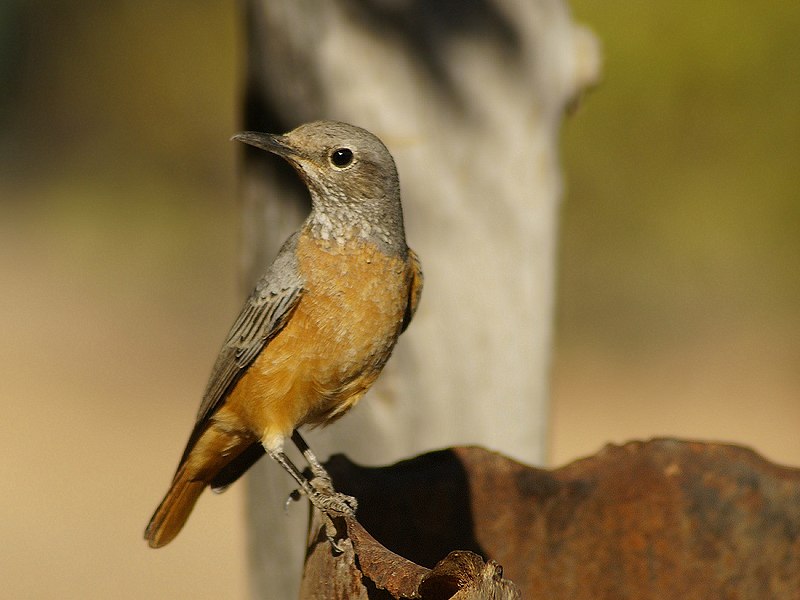
The Short-toed rock thrush is a species of bird belonging to the Muscicapidae family. Found in Angola, Botswana, Namibia, and South Africa, it inhabits subtropical or tropical dry shrubland.
The bird has a short-toed appearance, due to which it is named. Although regarded as a separate species, birds in the eastern part of its range are commonly known as the Pretoria rock thrush or Transvaal rock thrush.
They have a unique and pleasant chirping as a sign of their presence. Their habitat comprises of rocky terrains and small crevices where they build their nests.
Males have bluish-grey upperparts and orange-brown underparts with white spots, while females have duller plumage.
Short-toed rock thrushes actively forage for prey like insects and small vertebrates. They are known to migrate over short distances during winter.
The bird is fascinating to watch, and their melodious calls capture the hearts of many bird enthusiasts.Scientific classification:
| Kingdom | Animalia |
| Phylum | Chordata |
| Class | Aves |
| Order | Passeriformes |
| Family | Muscicapidae |
| Genus | Monticola |
| Species | M. brevipes |
28. Stark’s Lark
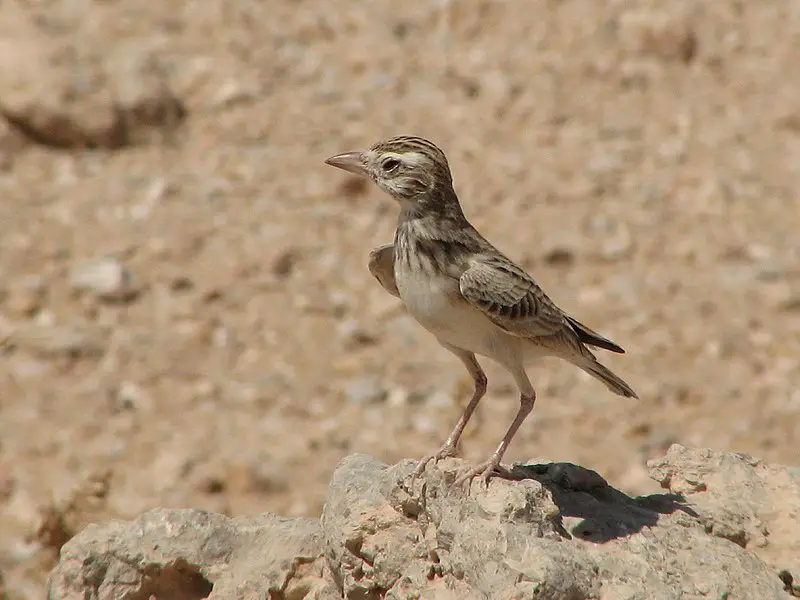
Stark’s lark is a bird belonging to the Alaudidae family, found in dry savannah and subtropical or tropical dry shrubland regions of Angola, Botswana, Namibia, and South Africa.
The species was named after Arthur Stark by Captain George Shelley. It was initially classified in Calandrella genus but later moved to Eremalauda. The bird is known for its distinct appearance and unique vocalization.
It has a small body size and is often seen flying close to the ground. Stark’s lark is an important part of the ecosystem and plays a crucial role in maintaining the balance of nature.
Despite being present in multiple countries, the bird is considered near threatened due to habitat loss and other anthropogenic factors.
Conservation efforts are being made to protect the species and preserve their habitats.Scientific classification:
| Kingdom | Animalia |
| Phylum | Chordata |
| Class | Aves |
| Order | Passeriformes |
| Family | Alaudidae |
| Genus | Spizocorys |
| Species | S. starki |
29. Chestnut Weaver
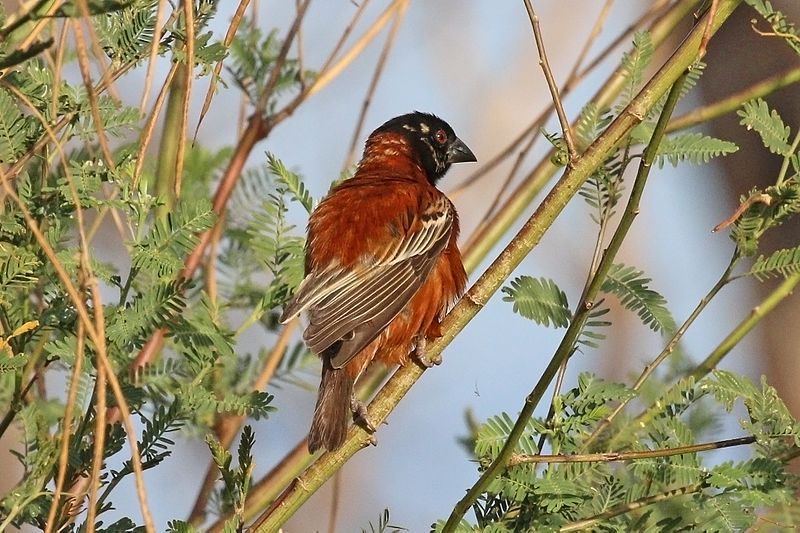
The chestnut weaver is a bird species that belongs to the Ploceidae family, living in eastern and south-western regions of Africa. This species has a distinct chestnut color, which distinguishes it from other birds.
Their habitat is usually located in areas with tall grasses, bushes, and savannas. Chestnut weavers are well-known for their weaving skills, constructing intricate nests out of long grasses and blades. These nests can be seen hanging from still plants, trees, or even power lines.
Chestnut weavers form monogamous pairs during breeding season, and the female lays up to three eggs in a nest.
This species of bird feeds on seeds, insects, and fruits. Chestnut weavers are also known for their singing abilities, producing a melodious tune that complements their appearance.
It is fascinating to observe the chestnut weaver’s lifestyle and habits, offering an insight into the diversity and beauty of the avian world.Scientific classification:
| Kingdom | Animalia |
| Phylum | Chordata |
| Class | Aves |
| Order | Passeriformes |
| Family | Ploceidae |
| Genus | Ploceus |
| Species | P. rubiginosus |
30. Pink-Billed Lark
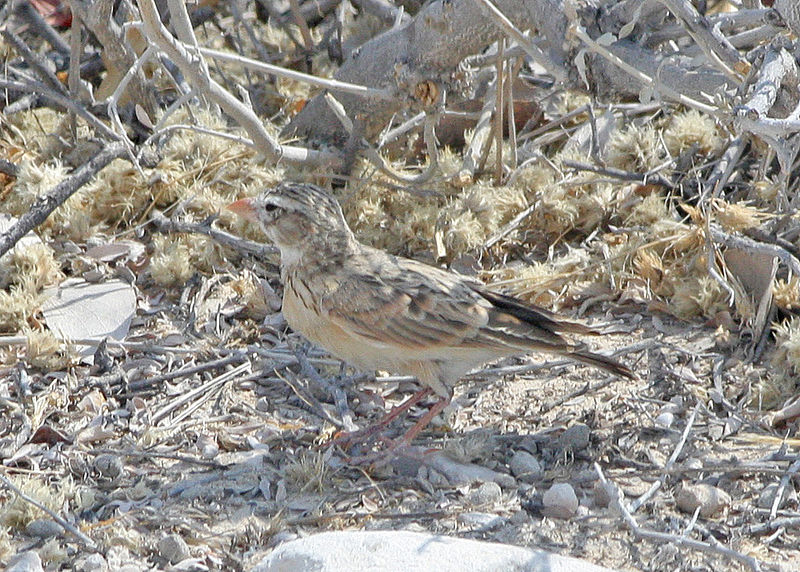
The Pink-billed lark is a species of lark found in southern Africa. This bird is commonly observed in subtropical or tropical dry lowland grassland. It is a small bird known for its pink-colored beak in contrast with its gray-brown plumage.
The Pink-billed lark was previously classified under the Alauda genus, but some authorities have placed it under the Calandrella genus.
There are six subspecies of this bird. Despite its small size, the Pink-billed lark is a fascinating bird known for its unique features and habitat preference.Scientific classification:
| Kingdom | Animalia |
| Phylum | Chordata |
| Class | Aves |
| Order | Passeriformes |
| Family | Alaudidae |
| Genus | Spizocorys |
| Species | S. conirostris |
31. Black-Faced Babbler
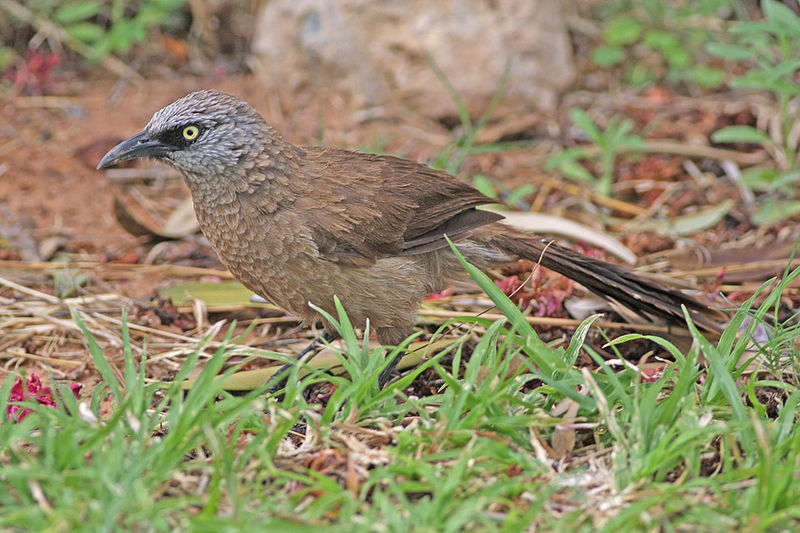
The black-faced babbler is a type of songbird from the family Leiothrichidae. It can be found in areas such as northwestern Botswana, northern Namibia, and Angola.
This bird is commonly found close to the ground, around thick woody vegetation, and sometimes in cultivated areas. Despite once being grouped with the black-lored babbler, A.
sharpei, it is now considered a species of its own. Its appearance includes a striking black face, distinguishing it from other babblers.
The black-faced babbler is a remarkable bird that is known for its beautiful vocalizations and social nature within its community.Scientific classification:
| Kingdom | Animalia |
| Phylum | Chordata |
| Class | Aves |
| Order | Passeriformes |
| Family | Leiothrichidae |
| Genus | Turdoides |
| Species | T. melanops |
32. Monotonous Lark
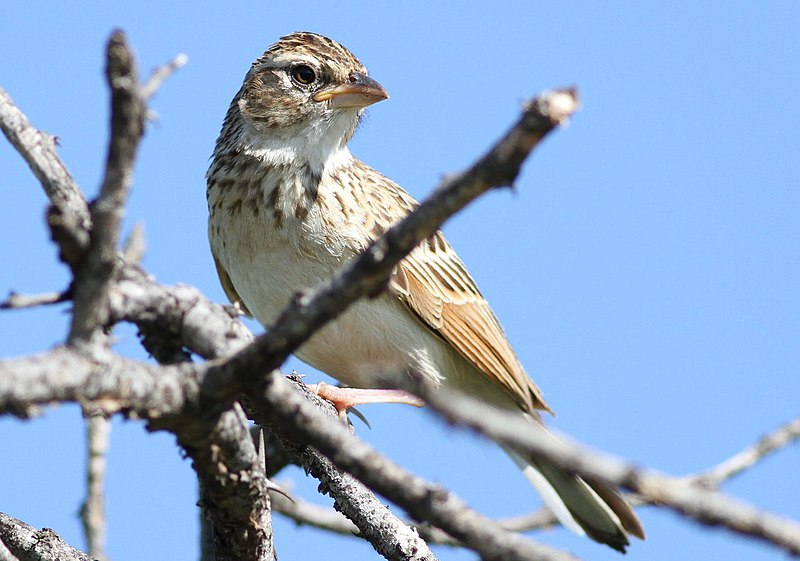
The monotonous lark, a member of the Alaudidae family, can be found across southern Africa. It should not be confused with the white-tailed lark or white-tailed bush-lark, which are separate species.
Other names for this bird include monotonous bush lark and Southern white-tailed bush-lark. The range of the monotonous lark is quite vast, extending to various regions in southern Africa.Scientific classification:
| Kingdom | Animalia |
| Phylum | Chordata |
| Class | Aves |
| Order | Passeriformes |
| Family | Alaudidae |
| Genus | Mirafra |
| Species | M. passerina |
33. Crimson-Breasted Shrike
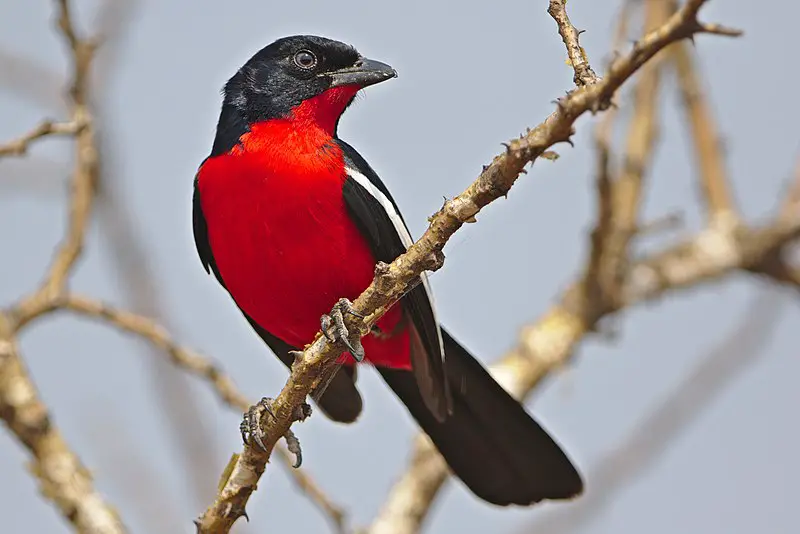
The Crimson-breasted Shrike, also known as the Crimson-breasted Gonolek or Boubou, is a bird found in southern Africa. It has black upper parts and a white flash on its wings, contrasting with bright scarlet underparts.
Interestingly, the name “gonolek” is supposedly based on the bird’s call. While the species is not considered threatened at the moment, it is still important to ensure its habitat and population remain stable for years to come.Scientific classification:
| Kingdom | Animalia |
| Phylum | Chordata |
| Class | Aves |
| Order | Passeriformes |
| Family | Malaconotidae |
| Genus | Laniarius |
| Species | L. atrococcineus |
34. African Pipit
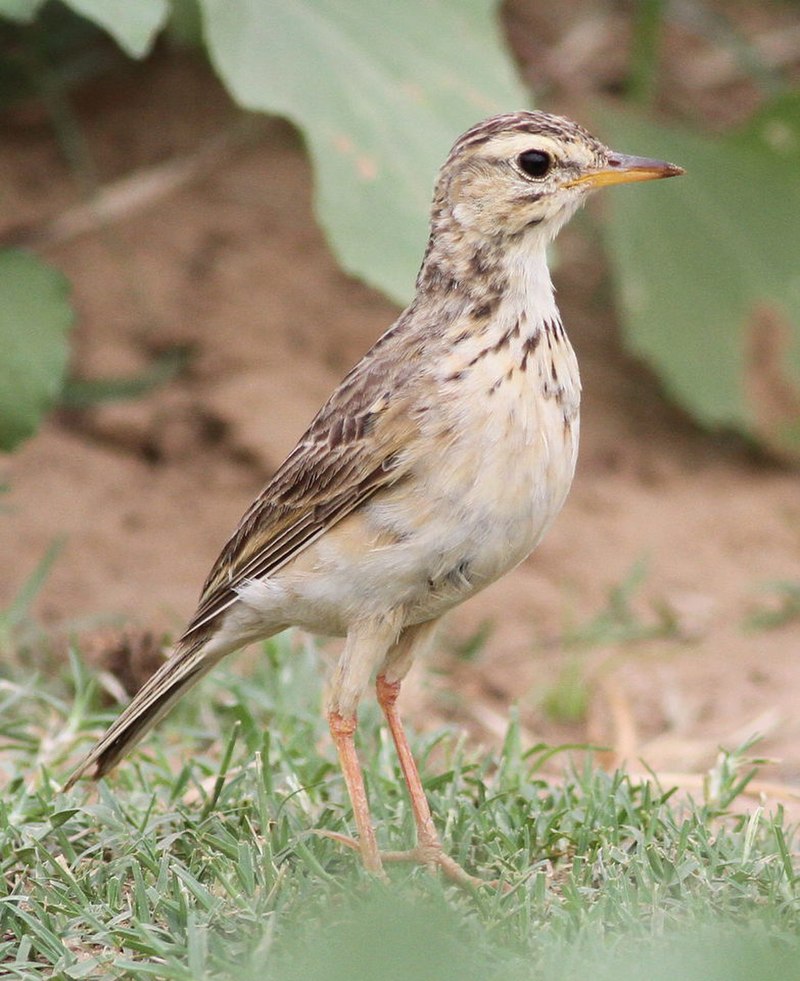
The African pipit, also called the grassveld or grassland pipit, is a small passerine bird found in the family Motacillidae. This bird belongs to the Anthus genus, and it was previously classified with several other pipits.
However, it is now treated as a distinct species. The African pipit is native to grasslands and savannas across sub-Saharan Africa, where it feeds on insects and seeds.
It is a common sight in these habitats, and its small size and brownish plumage help it blend in with its surroundings.
The African pipit is known for its distinctively long hind claws, which make it well-suited for walking on the ground.
This bird is not currently considered to be endangered, though it may be threatened by habitat loss in some areas.Scientific classification:
| Kingdom | Animalia |
| Phylum | Chordata |
| Class | Aves |
| Order | Passeriformes |
| Family | Motacillidae |
| Genus | Anthus |
| Species | A. cinnamomeus |
35. White-Browed Sparrow-Weaver
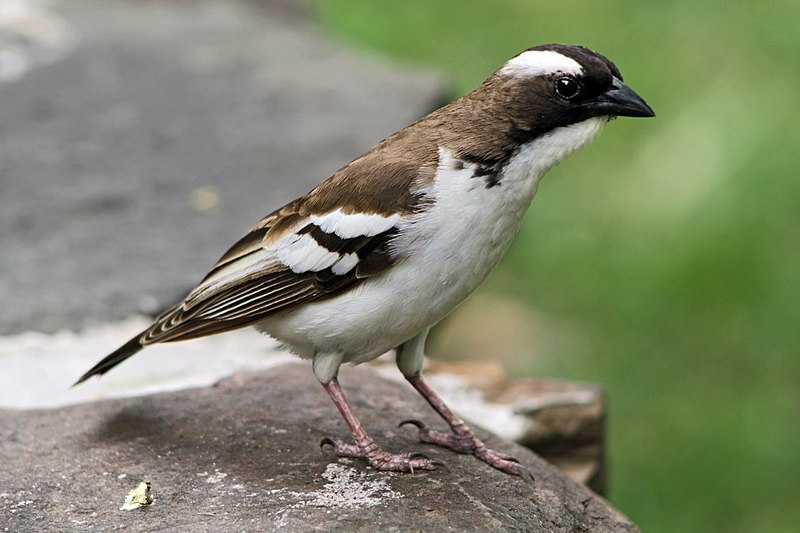
The white-browed sparrow-weaver is a small bird that inhabits central and north-central southern Africa. It has a predominantly brown plumage, and is about the size of a sparrow.
These birds are social and are often found in groups of up to eleven individuals, with one breeding pair and other non-reproductive birds. They were first collected by Andrew Smith during an expedition in 1834-35.
The white-browed sparrow-weaver is commonly found in grasslands, savannas, and shrublands, where they forage for seeds and insects.
Overall, this bird is an interesting species for bird enthusiasts and nature lovers, especially those interested in African wildlife.Scientific classification:
| Kingdom | Animalia |
| Phylum | Chordata |
| Class | Aves |
| Order | Passeriformes |
| Family | Ploceidae |
| Genus | Plocepasser |
| Species | P. mahali |
36. Sabota Lark
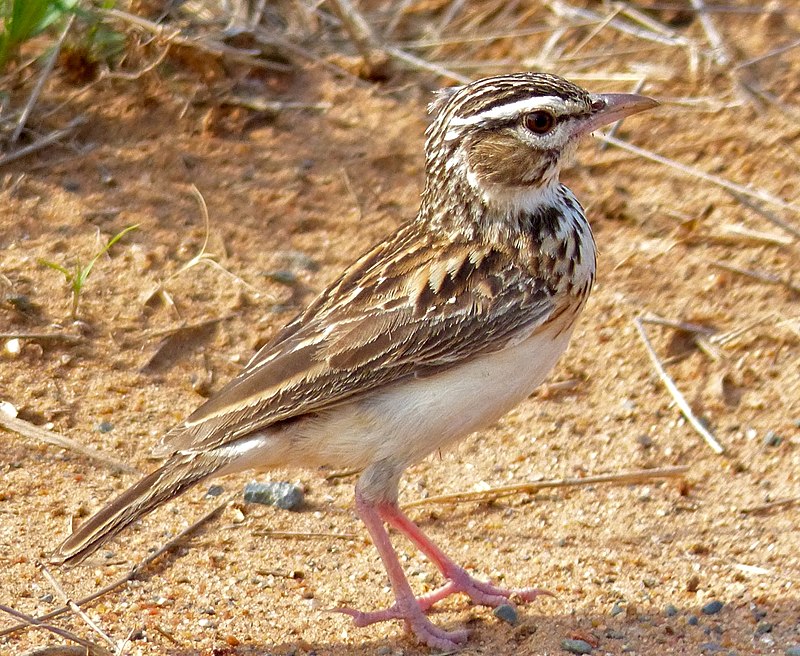
The Sabota lark is a bird species found in the dry savannah, moist savannah, and subtropical or tropical dry shrubland regions of southern Africa.
It belongs to the Alaudidae family and was formerly classified under the genus Mirafra before being moved to Calendulauda in 2009.
However, there are still some authorities that have not followed this re-classification. The Sabota lark is a beautiful bird with a unique song that can often be heard in its natural habitat.Scientific classification:
| Kingdom | Animalia |
| Phylum | Chordata |
| Class | Aves |
| Order | Passeriformes |
| Family | Alaudidae |
| Genus | Calendulauda |
| Species | C. sabota |
37. Double-Banded Sandgrouse
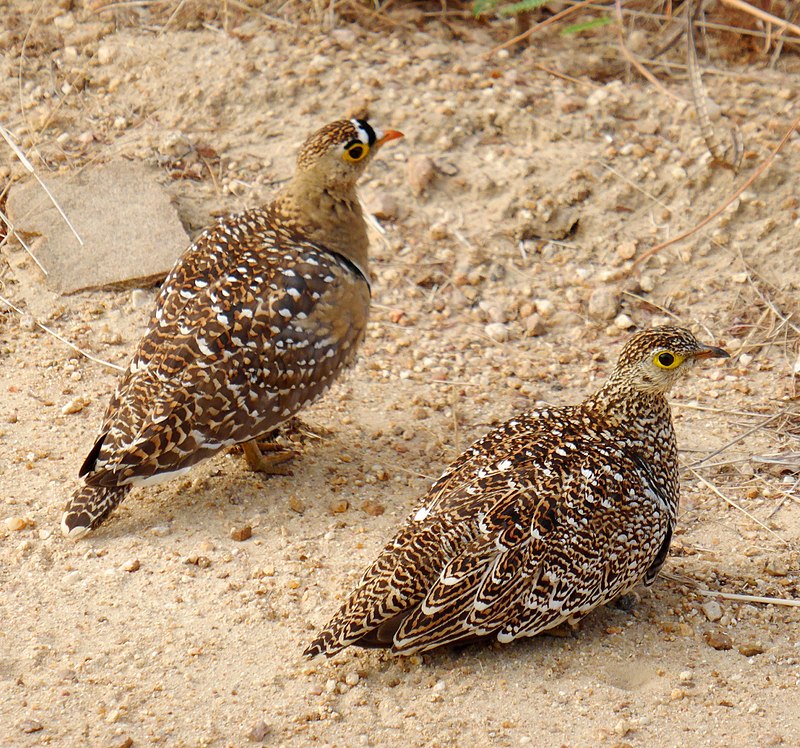
The Double-banded sandgrouse is a bird species that primarily inhabits arid regions of southern Africa. This ground-living bird belongs to the Pteroclidae family and is recognized for its distinct double bands.
It has three subspecies, the ansorgei is located in southwestern Angola, bicinctus in Botswana, Namibia and the northwestern part of Cape Province and multicolor located in Zambia, Mozambique, Malawi, and Transvaal.
This bird often nests on the ground and is known for its beautiful plumage that blends well with its dry surroundings. The Double-banded sandgrouse bird is often seen in small flock sizes and feeds mainly on seeds and herbs.
Overall, the Double-banded sandgrouse is a unique and fascinating bird that is well adapted to its arid environment.Scientific classification:
| Kingdom | Animalia |
| Phylum | Chordata |
| Class | Aves |
| Order | Pterocliformes |
| Family | Pteroclidae |
| Genus | Pterocles |
| Species | P. bicinctus |
38. Southern White-Crowned Shrike
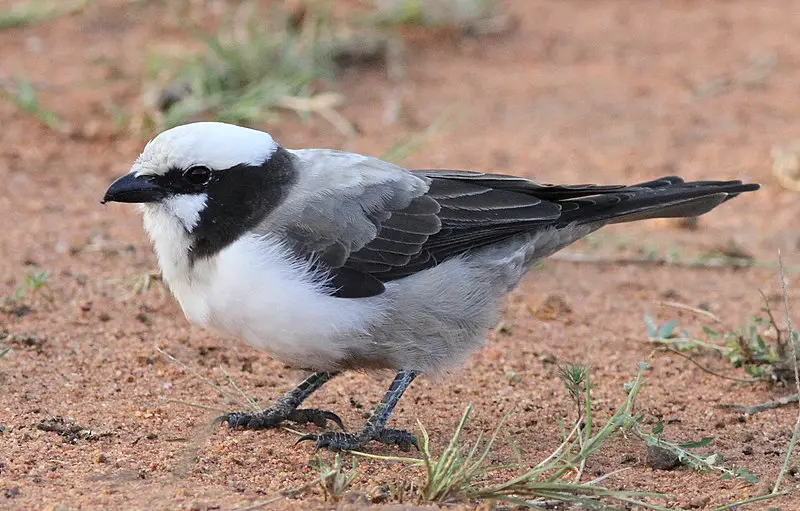
The Southern white-crowned shrike is a bird species from the Laniidae family. It can be found in Angola, Botswana, Mozambique, Namibia, South Africa, and Zimbabwe, usually in subtropical or tropical dry forests, and dry savannahs.
This bird species is about 24 cm long and has similar features in both sexes, with a white crown and black patches around the eyes.
Southern white-crowned shrikes are often seen perched on high spots, from which they swoop down on their prey, usually small insects and lizards.
They are known for being territorial birds that defend their nests vigorously. The Southern white-crowned shrike is an important predator in its ecosystem, playing a role in controlling insect populations.
Together with their beautiful appearance and unique behaviors, they are a valuable part of Africa’s wildlife.Scientific classification:
| Kingdom | Animalia |
| Phylum | Chordata |
| Class | Aves |
| Order | Passeriformes |
| Family | Laniidae |
| Genus | Eurocephalus |
| Species | E. anguitimens |
39. Shaft-Tailed Whydah
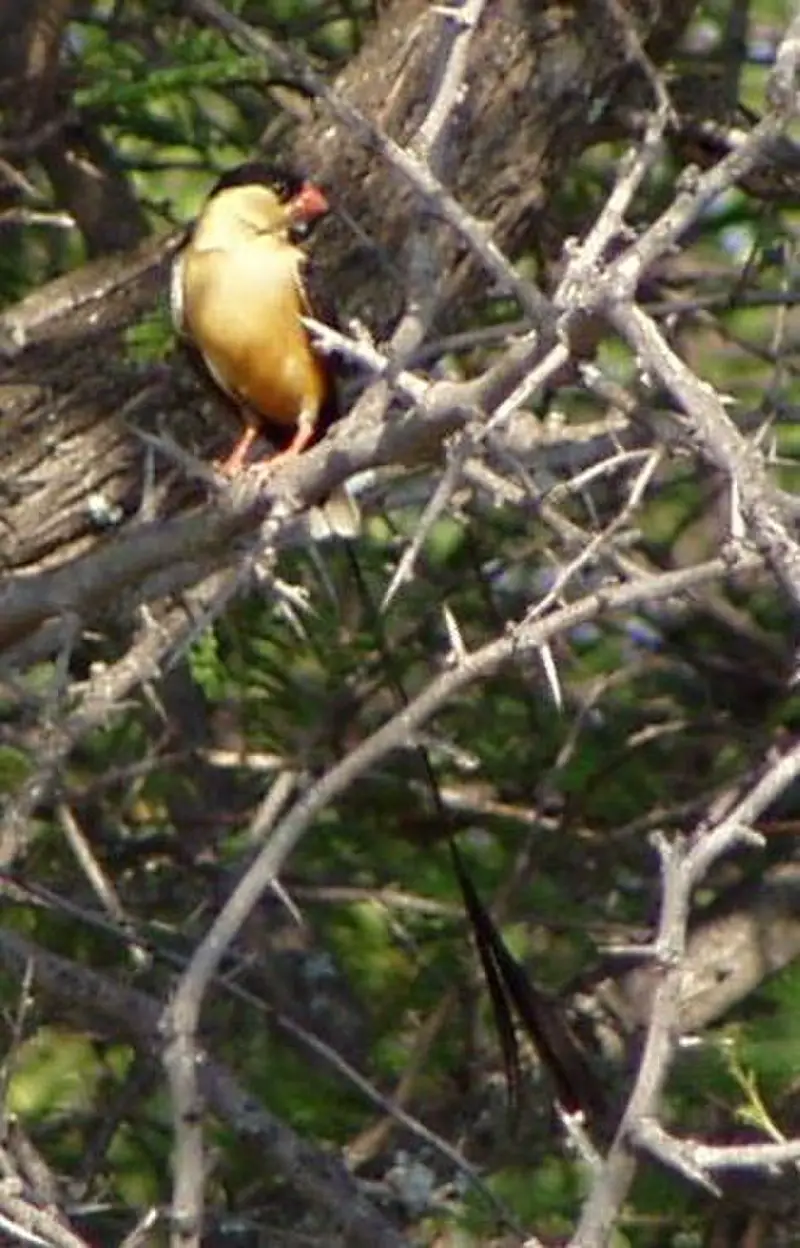
The shaft-tailed whydah, also known as the queen whydah, is a sparrow-like bird belonging to the genus Vidua.
During the breeding season, the male dons a striking black crown and upper body plumage, paired with a golden breast and four elongated black tail shaft feathers with expanded tips.
However, after the breeding season concludes, the male sheds its long tail and develops an olive-brown female-like plumage.
The shaft-tailed whydah is distributed across various parts of Africa and is known for its elaborate courtship displays.
This bird is known to engage in brood parasitism, meaning it lays its eggs in the nests of other bird species.
Despite its colorful breeding plumage, the shaft-tailed whydah is often considered a pest in areas where it has been introduced as it can harm native bird species by invading their nests and disrupting their breeding habits.Scientific classification:
| Kingdom | Animalia |
| Phylum | Chordata |
| Class | Aves |
| Order | Passeriformes |
| Family | Viduidae |
| Genus | Vidua |
| Species | V. regia |
40. Gabar Goshawk
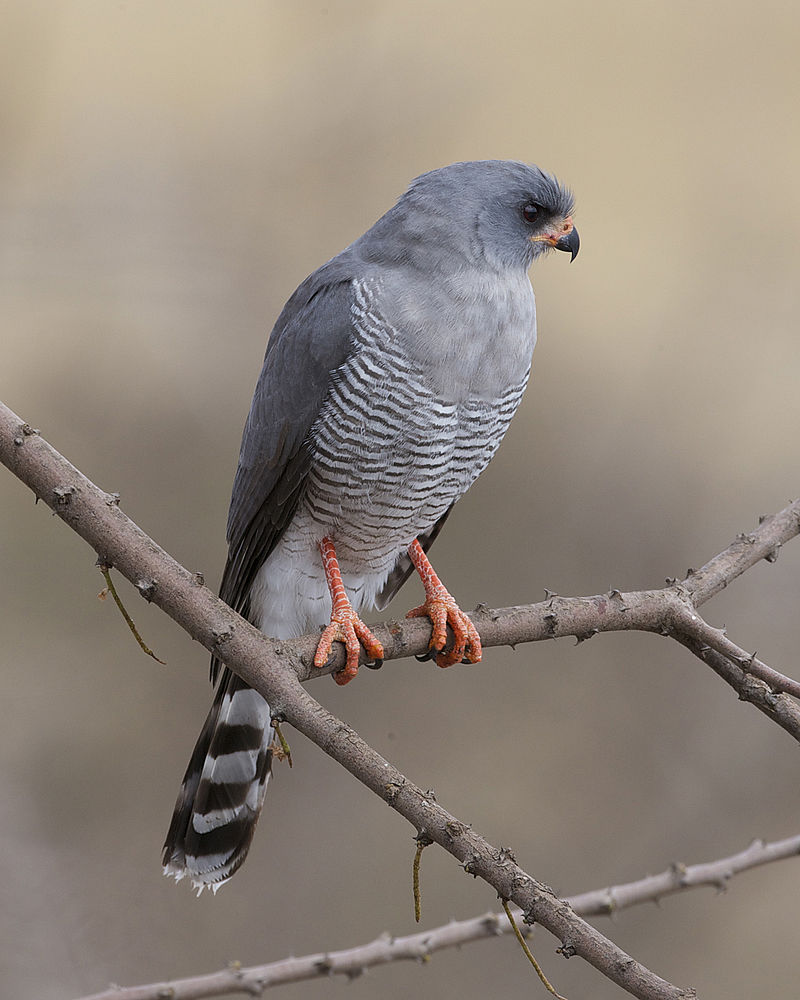
The Gabar goshawk is a bird of prey found in Africa and Arabia. It belongs to the Accipitridae family and comes in two distinct forms that vary in abundance throughout their range.
One form has grey upperparts with a white rump and grey and white barring on the chest, while the other form is darker.
It is a small bird, known for its agility and swift flight. As a predator, the Gabar goshawk feeds on small mammals, birds and reptiles.
It has sharp talons and a hooked beak, which allow it to catch its prey. The Gabar goshawk is often found in woodlands and savannas, where it nests in trees.
It is a beautiful bird that fascinates birdwatchers and naturalists alike, and its presence is an important indicator of the health of its ecosystem.Scientific classification:
| Kingdom | Animalia |
| Phylum | Chordata |
| Class | Aves |
| Order | Accipitriformes |
| Family | Accipitridae |
| Genus | Micronisus G.R. Gray, 1840 |
| Species | M. gabar |
41. Rufous-Cheeked Nightjar
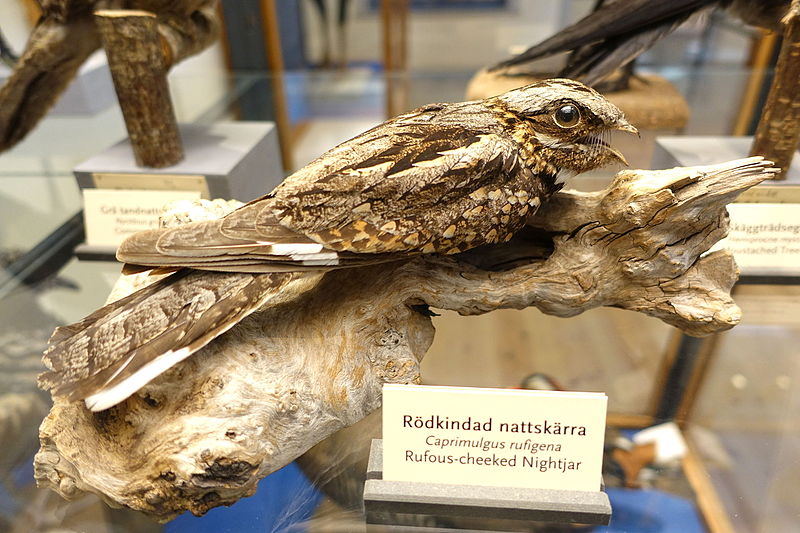
The rufous-cheeked nightjar is a type of bird that belongs to the Caprimulgidae family. It is known to be an intra-African migrant that breeds in the southern part of its range.
During non-breeding season, this bird can be found in different African countries including Nigeria, Cameroon, Chad, Sudan, Republic of Congo, D.R.C., and Central African Republic.
Interestingly, the bird spends its summers in Angola. This makes it a highly adaptable species that can survive and thrive in different environmental conditions.
Due to its unique features, the rufous-cheeked nightjar is often studied and observed by ornithologists who seek to understand its behavior and lifestyle.
Overall, this bird is a fascinating and complex creature that adds to the beauty and diversity of the animal kingdom.Scientific classification:
| Kingdom | Animalia |
| Phylum | Chordata |
| Class | Aves |
| Clade | Strisores |
| Order | Caprimulgiformes |
| Family | Caprimulgidae |
| Genus | Caprimulgus |
| Species | C. rufigena |